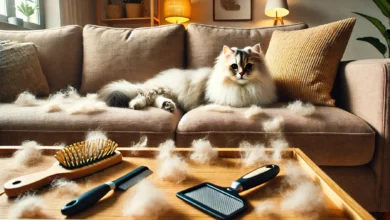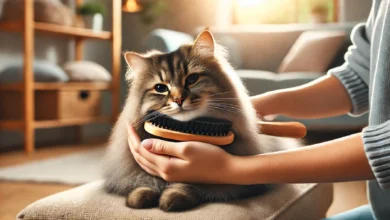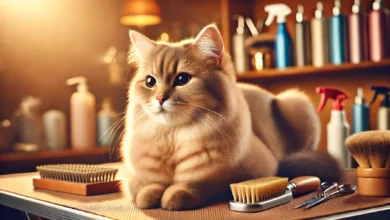Addressing Grooming Challenges with Hairless Cats
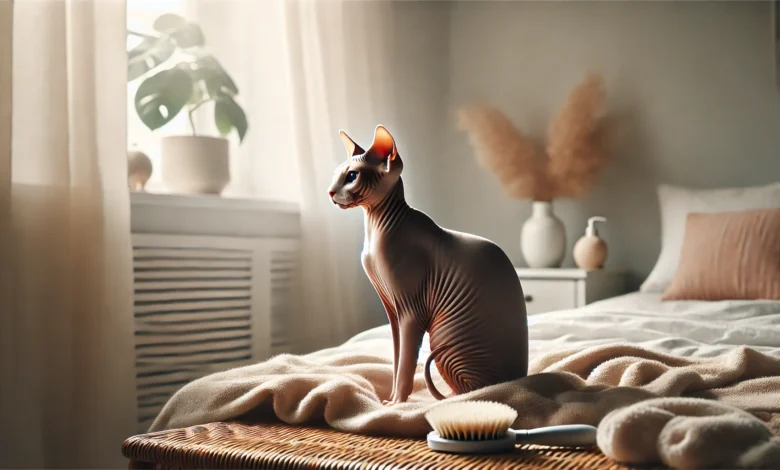
Grooming has largely been a hands-off procedure for most cat owners, especially with breeds renowned for self-grooming.
However, owning a hairless cat presents a different set of grooming challenges.
While it may seem that grooming a hairless cat would be easier due to the lack of fur, the reality is quite different.
In fact, hairless cats require as much attention, if not more, compared to their furred counterparts when it comes to grooming.
Their skin tends to get oily, collect dirt, and develop skin irritations, which cannot be managed without regular grooming.
In this article, we will explore grooming challenges with hairless cats and how you can address these issues to keep your feline healthy and clean.
Whether you are a new owner of a hairless cat or looking to improve your grooming routine, this guide will cover everything you need to know.
Table of Contents
Understanding Hairless Cat Breeds and Their Grooming Needs
Hairless cats are unique not only because they lack fur but also due to the special grooming requirements they have.
Unlike furry cats, hairless cats do not have a fur barrier to protect their skin from the elements, making them prone to dirt, oil buildup, and various skin conditions.
Knowing the specific breed of your hairless cat is important in understanding its grooming needs.
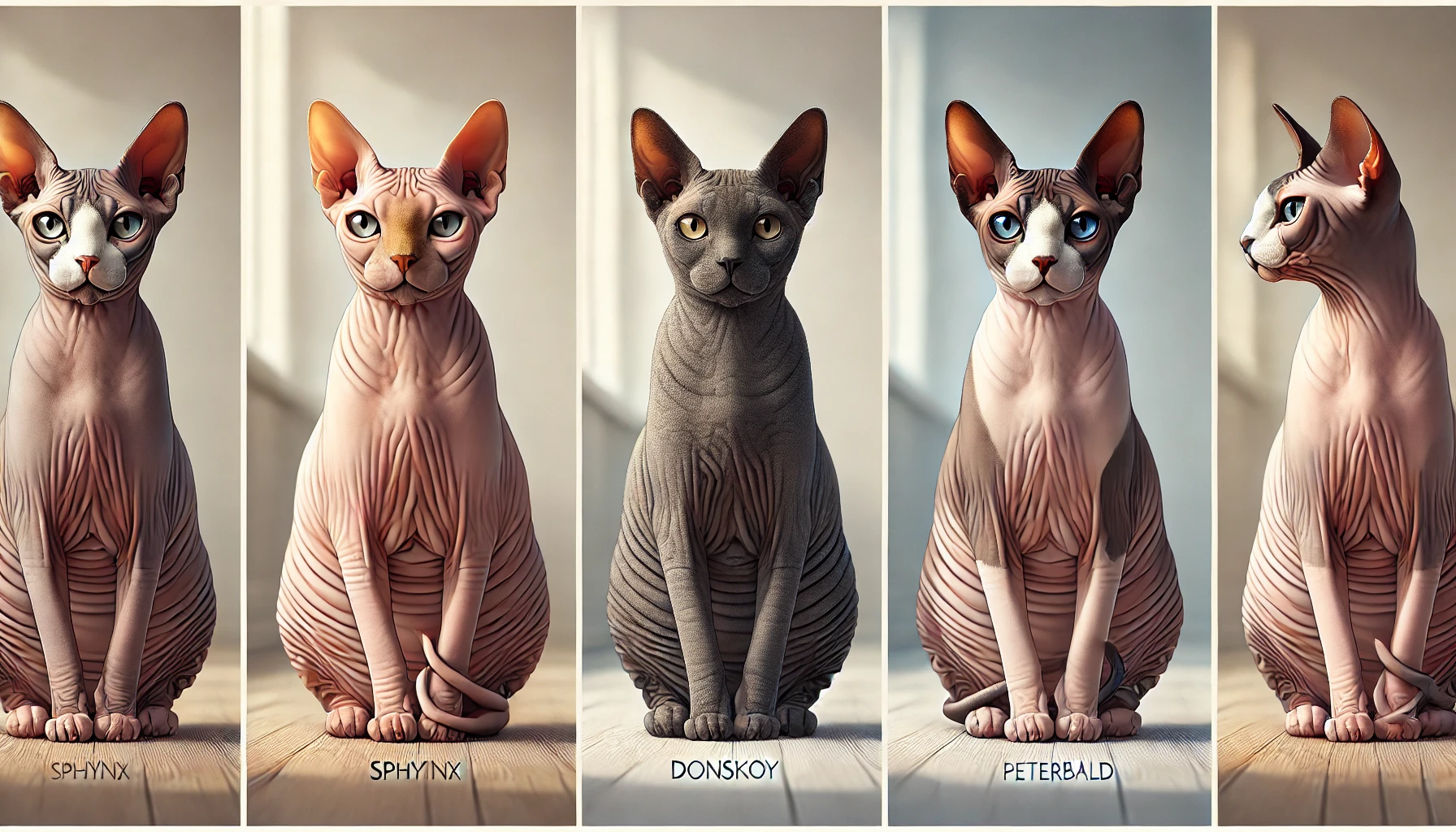
Common Hairless Cat Breeds: Sphynx, Donskoy, and Peterbald
While the Sphynx is the most popular hairless breed, it is not the only one.
Other hairless breeds include the Donskoy and the Peterbald.
These cats are specifically bred for their hairlessness, but they still require regular grooming despite their lack of fur.
Each breed may have different needs based on their skin type and genetic background.
- Sphynx: Known for their wrinkled skin and affectionate personality, Sphynx cats tend to have oilier skin compared to other breeds, requiring frequent cleaning.
- Donskoy: This breed has more elastic, thicker skin, which requires less frequent bathing but needs more attention to moisture retention.
- Peterbald: With a finer skin texture, Peterbald cats may need gentler products and frequent moisturizing to prevent irritation.
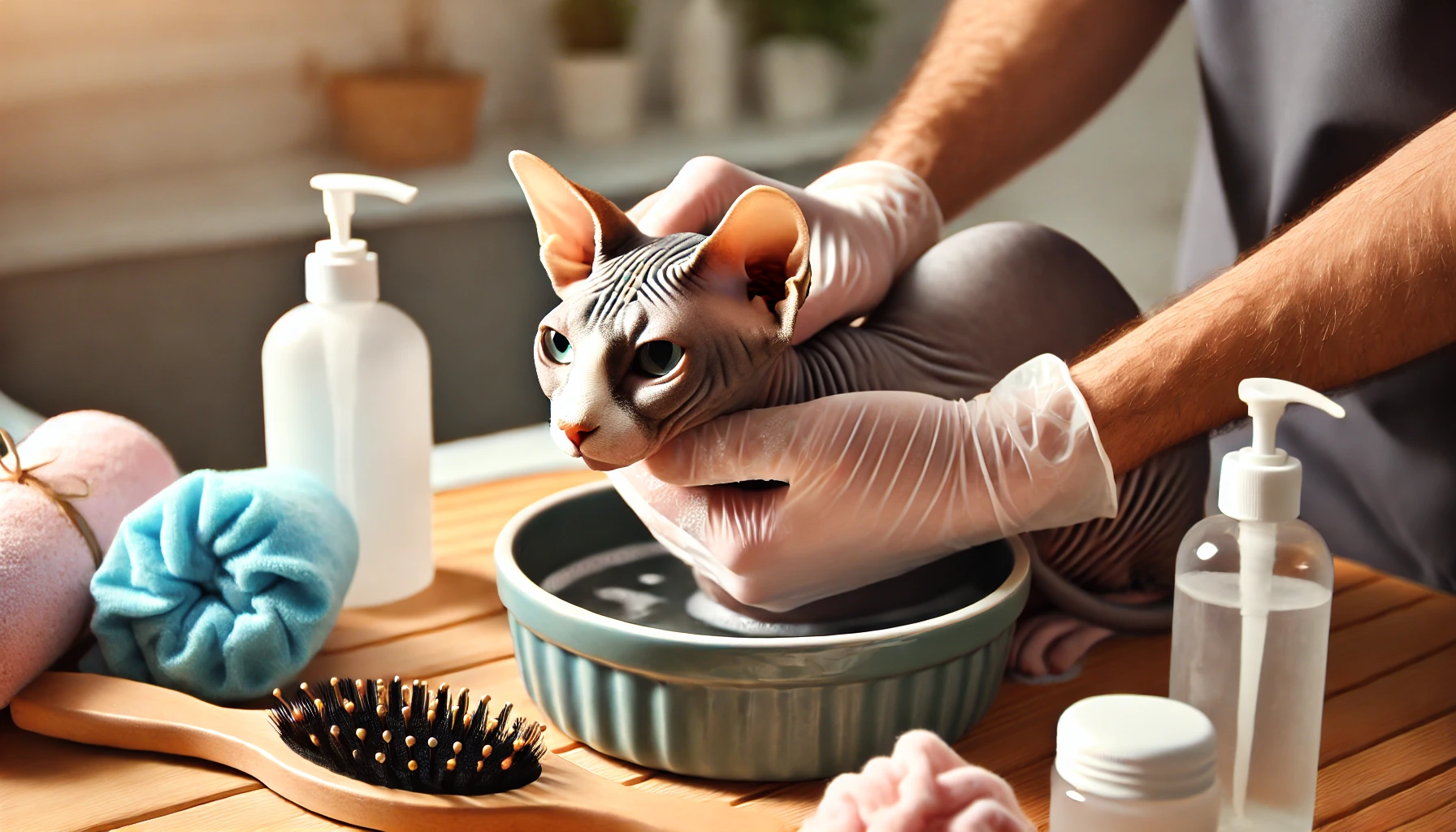
Why Hairless Cats Require Special Grooming
Without fur to absorb oils and protect their skin, hairless cats are prone to oil buildup, which can lead to odors, acne, and infections.
Their skin is also more exposed to environmental factors such as dust and allergens.
These factors highlight why hairless cats need regular grooming.
Their ears, paws, and any folds of skin are areas where dirt and bacteria can easily accumulate, so these should be cleaned frequently.
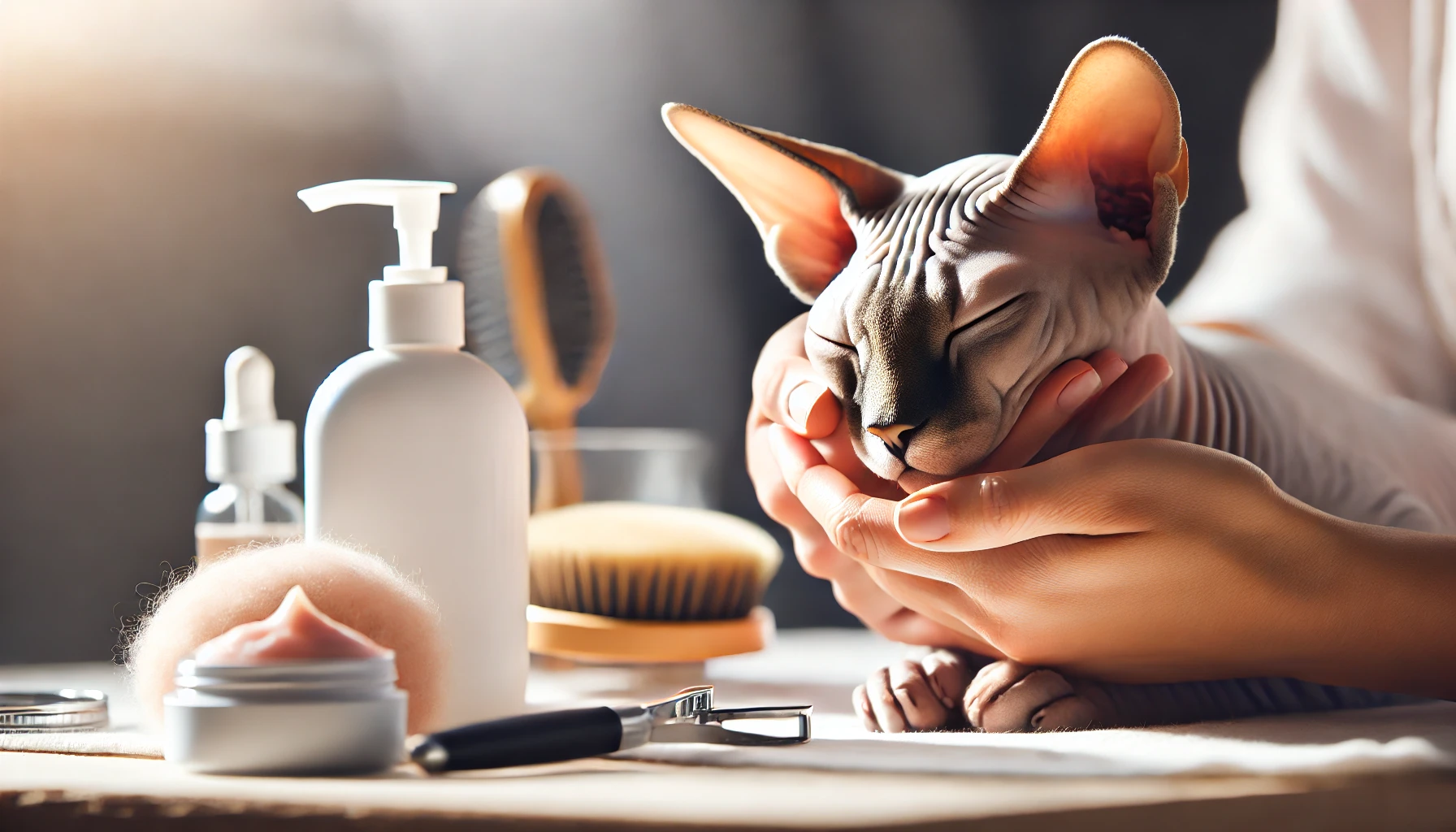
Skin Sensitivity and Grooming in Hairless Cats
One of the primary challenges in grooming hairless cats is their sensitive skin.
If not properly cared for, these cats can develop dry skin, irritations, and even sunburn.
To keep their skin healthy, it is important to use hypoallergenic grooming products and ensure regular moisturizing.
Bathing your cat regularly and paying special attention to problem areas like skin folds and wrinkles will help prevent irritation and maintain healthy skin.
Hairless cats, such as the Sphynx and Peterbald, require more grooming attention due to their lack of fur. Without the protection fur provides, these breeds are prone to oil buildup, dirt, and skin irritations.
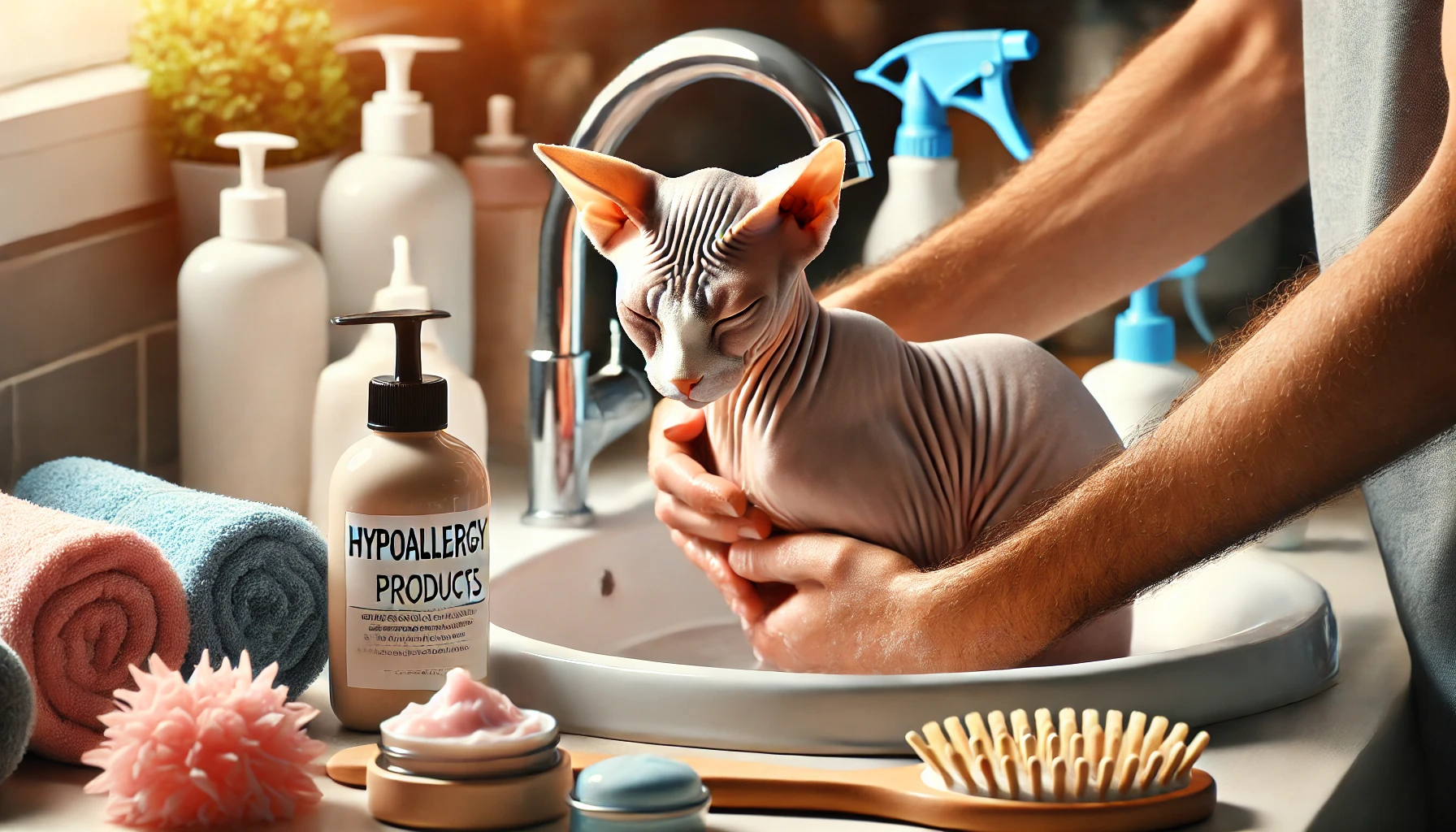
Managing Skin Care of Hairless Cats
One of the most critical elements of grooming a hairless cat is managing their skin care.
Without the fur that usually absorbs oils and acts as a layer of protection, the skin of these cats is exposed to environmental elements and prone to oil buildup, dryness, and even infection.
Proper skin care is essential for maintaining their health and comfort.
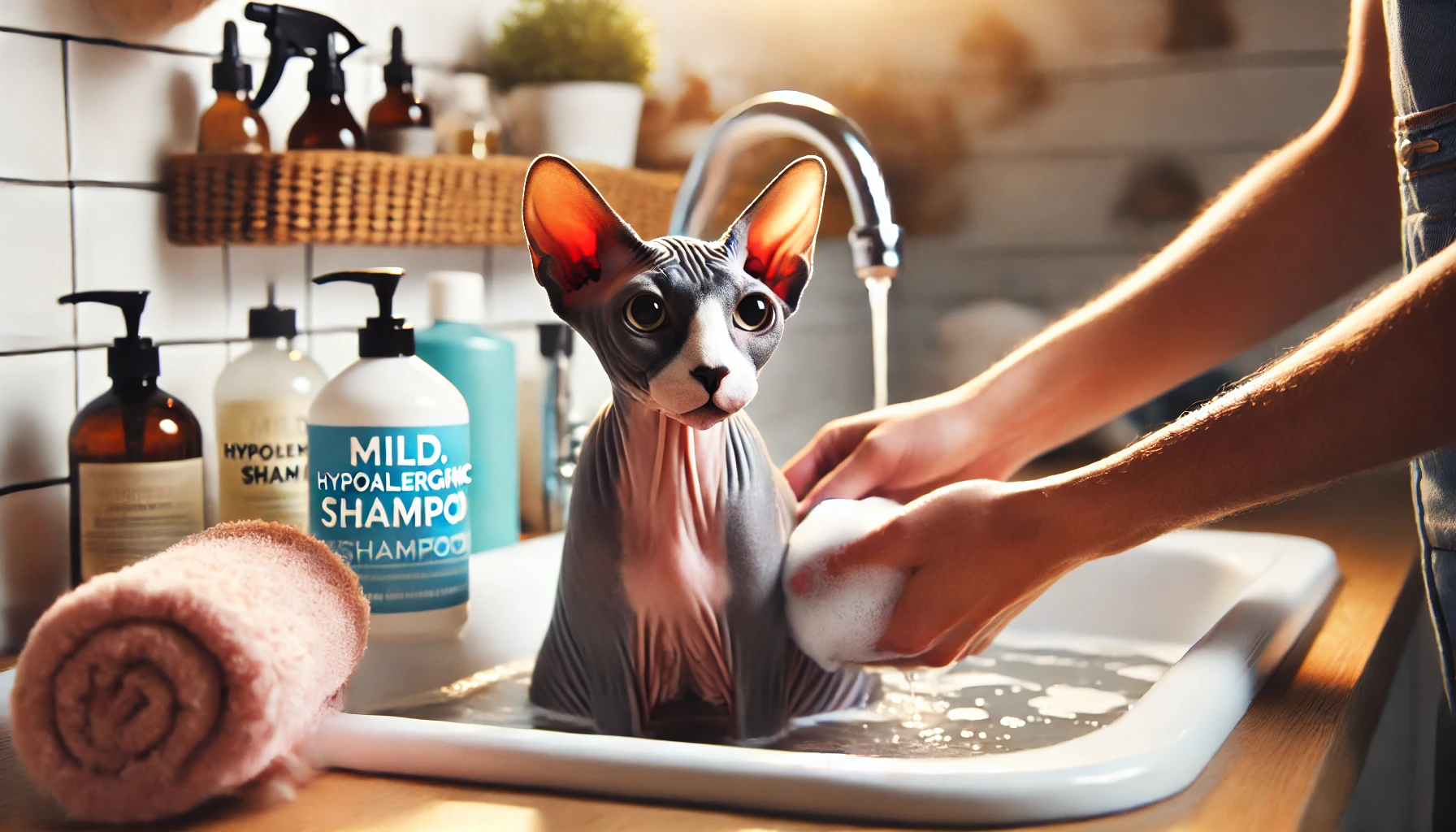
Bathing Routines: How Often and What Products to Use
Hairless cats, especially the Sphynx, tend to have oily skin.
This oiliness can cause dirt to build up on their skin and may lead to skin problems if not properly managed.
Regular bathing is necessary to keep their skin clean and healthy.
Most experts recommend bathing a hairless cat weekly to remove excess oils and accumulated dirt.
However, this can vary depending on your cat’s lifestyle and how much oil they produce.
When bathing your hairless cat, only mild, hypoallergenic cat shampoos that do not contain harsh chemicals should be used.
Human shampoos should never be applied as they dry out the skin and cause irritation.
Look for cat shampoos that are formulated for sensitive skin, ideally containing ingredients like oatmeal or aloe vera to soothe and protect your cat’s skin.
- Frequency: Bathe your hairless cat once a week or as needed, depending on oil buildup.
- Shampoo: Use a hypoallergenic shampoo that nourishes the skin and is safe for sensitive cats.
- Water Temperature: Use lukewarm water to avoid chilling your cat, as hairless cats are more sensitive to cold than furred cats.
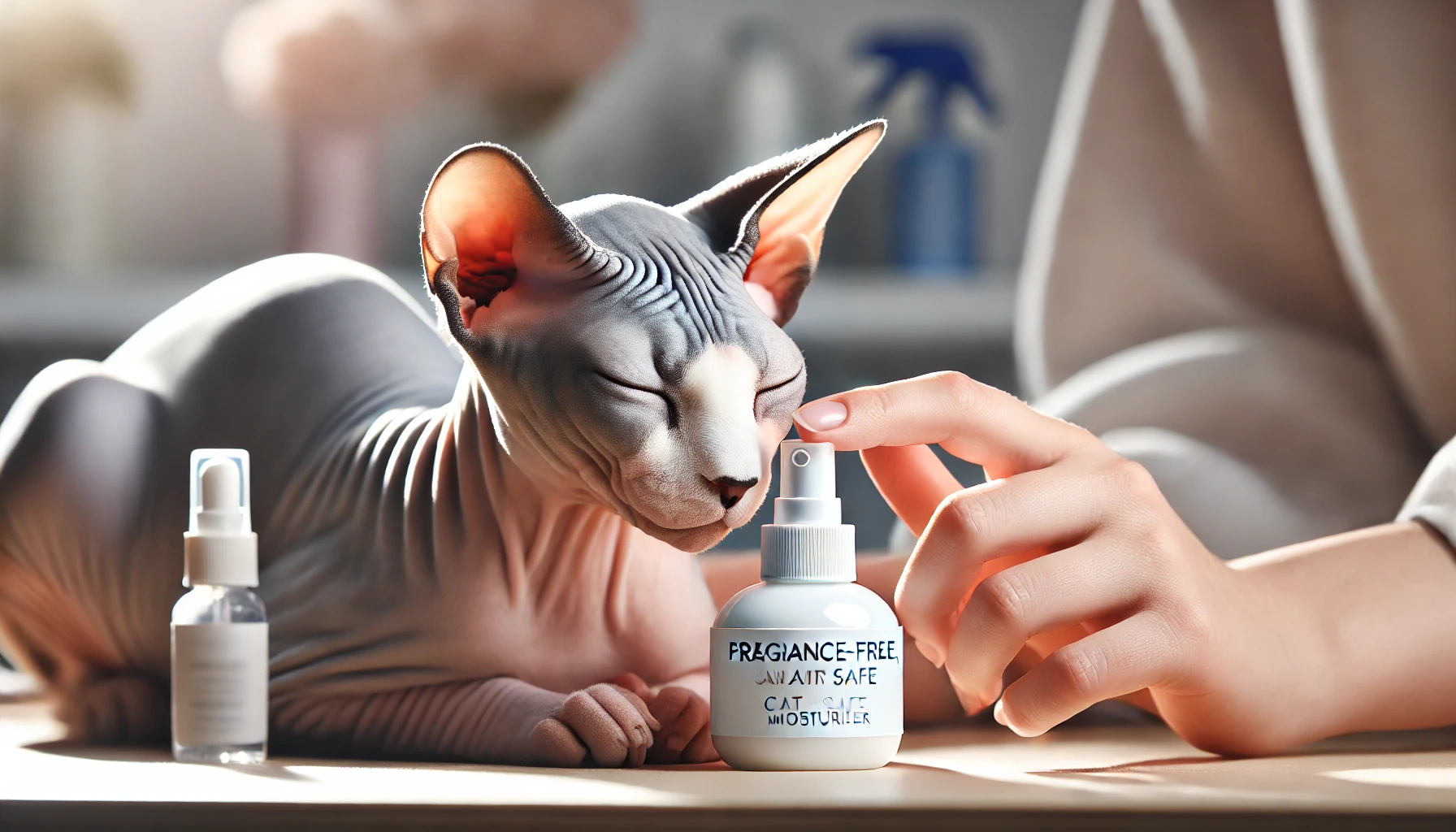
Moisturizing and Protecting Hairless Cat Skin
After bathing, it’s important to moisturize your hairless cat’s skin to prevent dryness and cracking.
Because their skin can dry out easily, applying a fragrance-free, cat-friendly moisturizer will help keep it supple and soft.
Be cautious not to over-moisturize, as too much can clog the skin’s pores and lead to other skin problems.
Focus on dry areas, especially around the elbows and skin folds, where cracking is more likely to occur.
Hairless cats are also more prone to sunburn, especially if exposed to direct sunlight.
If your cat enjoys sunbathing, consider using a pet-safe sunscreen.
Alternatively, provide shaded areas or dress them in lightweight clothing designed for hairless cats to protect their sensitive skin from UV damage.
- Moisturizer: Use a fragrance-free, cat-safe moisturizer on dry areas like elbows and folds.
- Sun Protection: Apply pet-safe sunscreen or protective gear if your cat is exposed to direct sunlight.
- Clothing: Lightweight fabrics can help protect your hairless cat’s skin from UV rays and temperature changes.
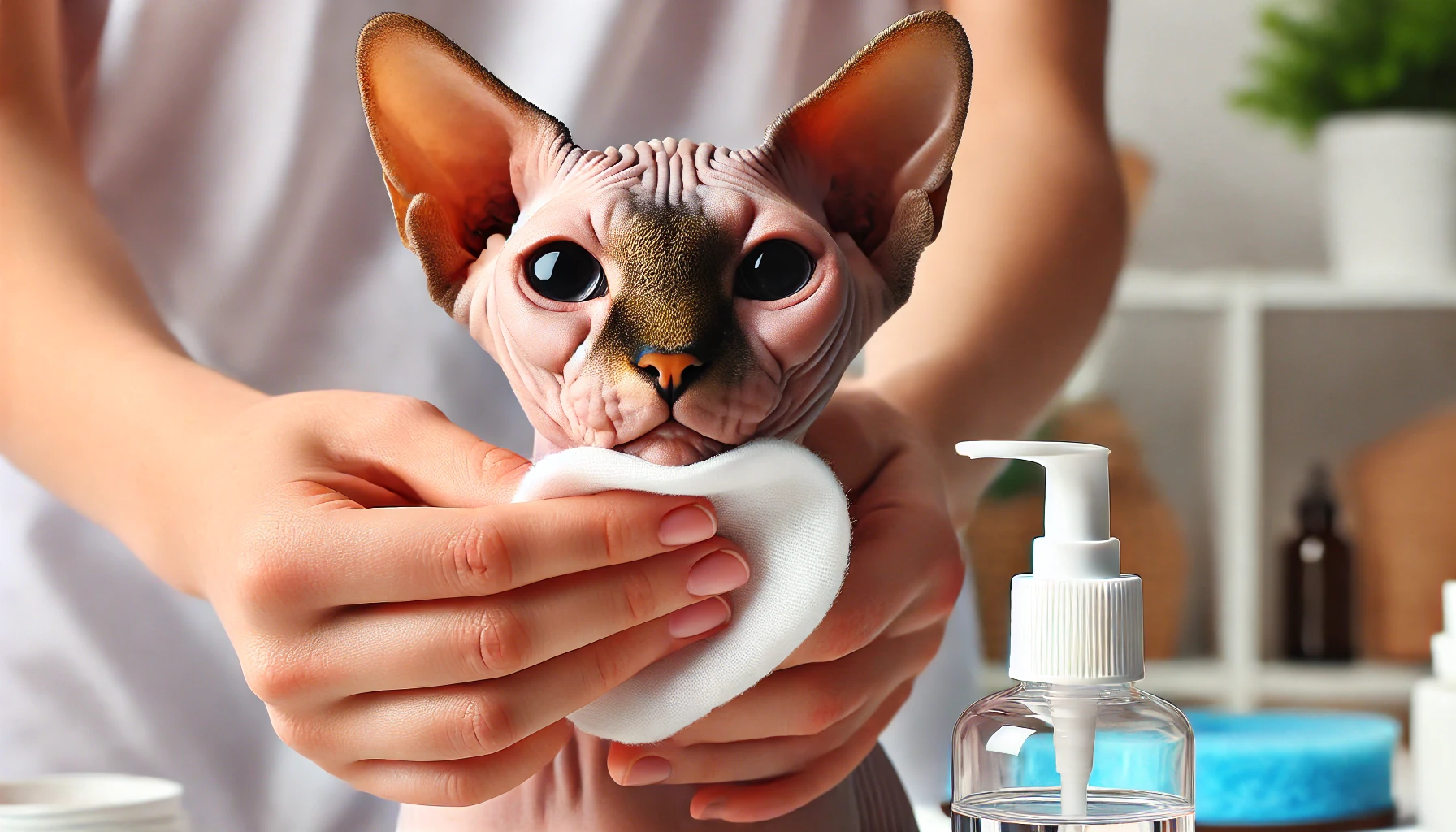
Managing Acne and Skin Irritations
Hairless cats are often prone to feline acne, particularly around the chin, which can result from oil accumulation and clogged pores.
For mild acne, gently clean your cat’s chin and other oil-prone areas using a mild, cat-safe cleanser or unscented baby wipes.
Avoid using harsh acne products meant for humans, as these can further irritate your cat’s skin.
If your cat experiences more serious skin irritations or infections, it’s best to consult with a veterinarian for proper treatment.
Regular cleaning, moisturizing, and careful attention to grooming can help prevent most skin problems.
- Feline Acne: Clean areas where oil buildup is common, such as around the chin.
- Veterinarian Consultation: Seek veterinary advice for serious skin irritations or infections.
- Preventive Care: Regular cleaning and moisturizing can help reduce the likelihood of skin problems.
Regular skin care, including weekly baths with hypoallergenic products and moisturizing, can prevent common skin problems such as dryness and acne in hairless cats.
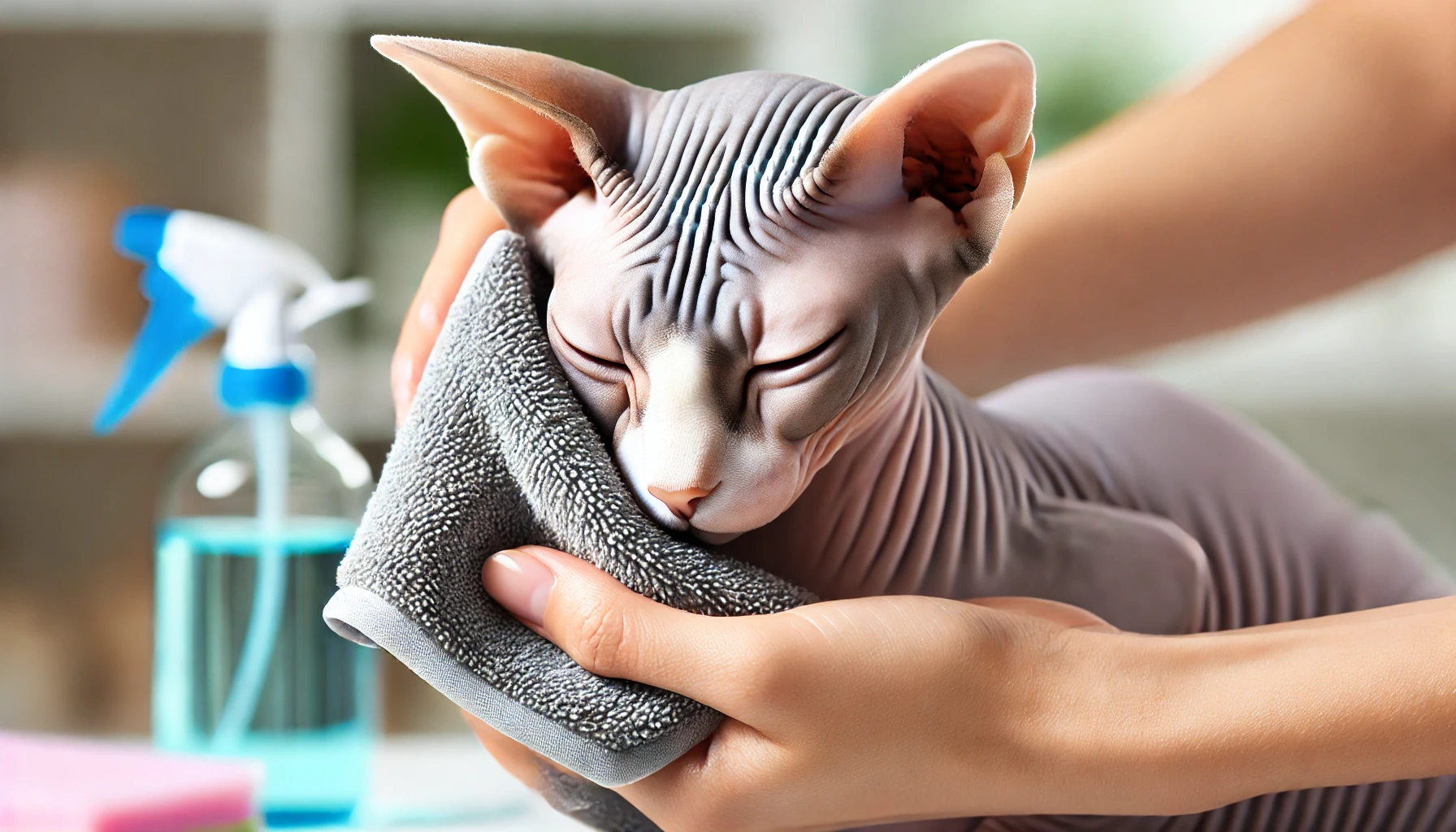
Cleaning Oil and Dirt off of Hairless Cats
One of the major grooming challenges with hairless cats is the accumulation of oil and dirt.
Without the protective barrier of fur, these cats don’t have the ability to absorb excess oils, unlike their furred counterparts.
As a result, their skin tends to get oily and dirty much faster.
If not properly cared for, this can lead to unpleasant odors, skin irritations, and infections.
Regular cleaning is crucial to prevent oil and dirt buildup, ensuring your hairless cat stays happy and healthy.
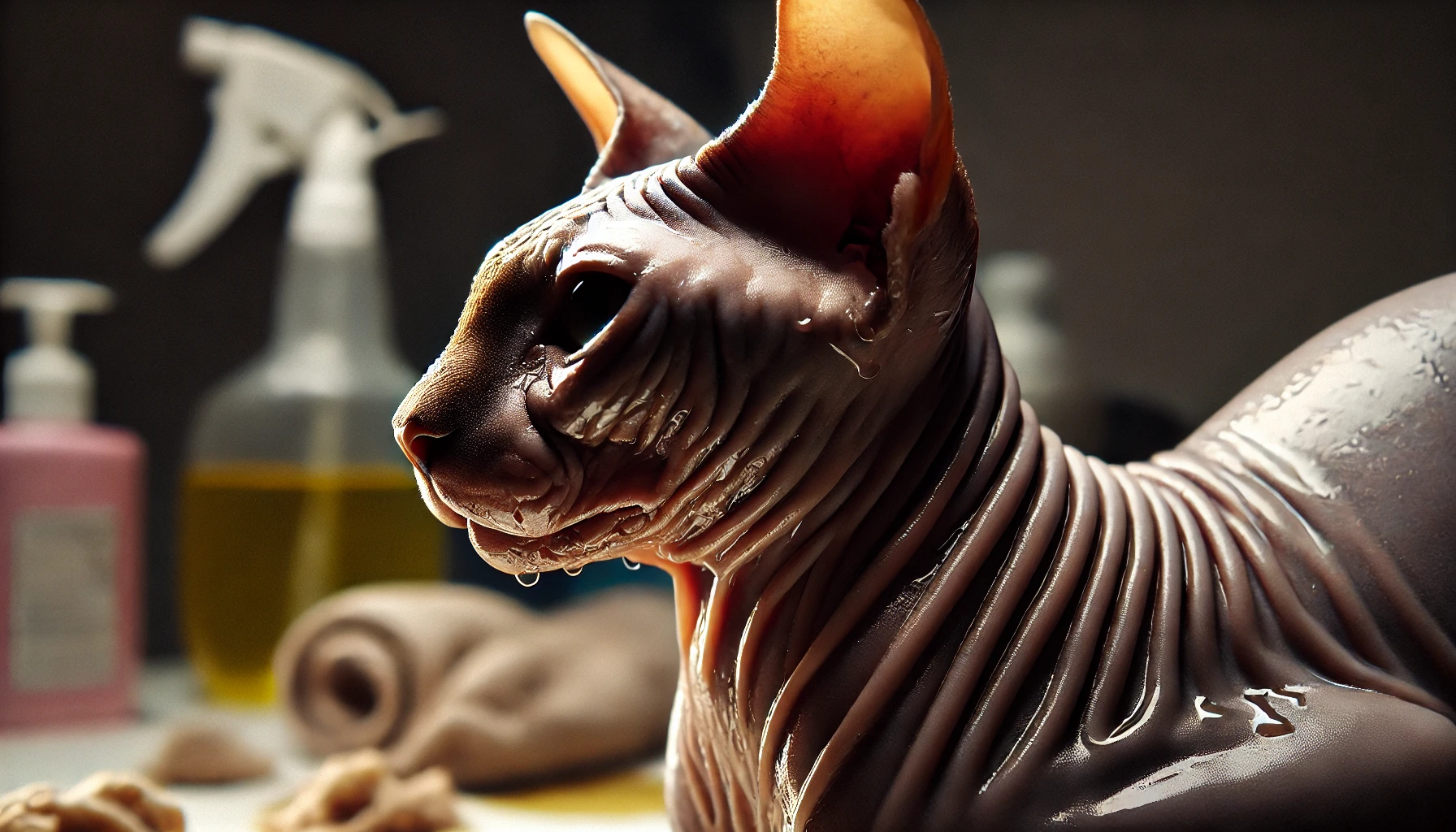
Why Hairless Cats Produce More Oil
The absence of fur means the sebaceous glands, responsible for producing oils that protect the skin, work overtime in hairless cats.
Normally, these oils would be absorbed by a cat’s fur, but since hairless breeds lack fur, the oils remain on the skin, giving the cat a greasy or shiny appearance.
While a small amount of oil is beneficial for maintaining healthy skin, excessive oil can trap dirt, clog pores, and lead to skin issues like acne or rashes.
This natural oil production means hairless cats require regular grooming to manage their skin condition.
A weekly or bi-weekly bath can help control excess oil and keep the skin clean.
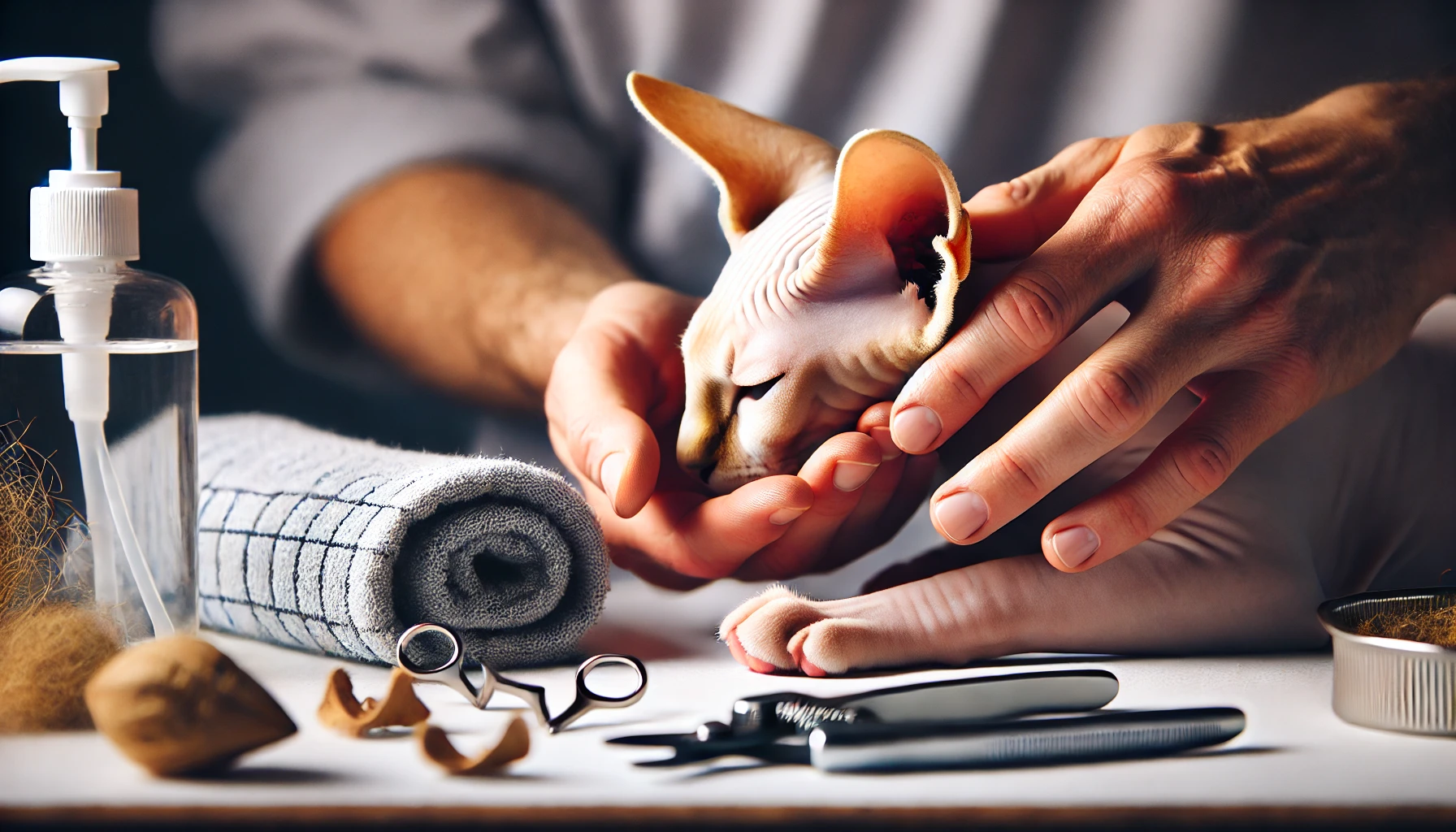
Cleaning Your Hairless Cat’s Ears, Paws, and Nails
Because they lack fur, hairless cats are more prone to dirt and oil buildup in areas like the ears, paws, and nails.
Without fur acting as a barrier, dust and particles can easily accumulate, making regular cleaning a necessity.
- Ears: Due to the absence of fur, hairless cats tend to accumulate wax in their ears. Clean the ears gently with a cotton ball or soft cloth dampened with a non-irritating, cat-safe ear cleaner. Avoid using cotton swabs, as they can push wax deeper into the ear canal.
- Paws: Dirt often builds up between your cat’s paw pads. Wipe them regularly with a damp cloth to keep them clean and prevent infections.
- Nails: Hairless cats can accumulate oils around their nails. Regularly trimming their nails and cleaning the area around the nails helps prevent dirt and bacteria from collecting, reducing the risk of infections.
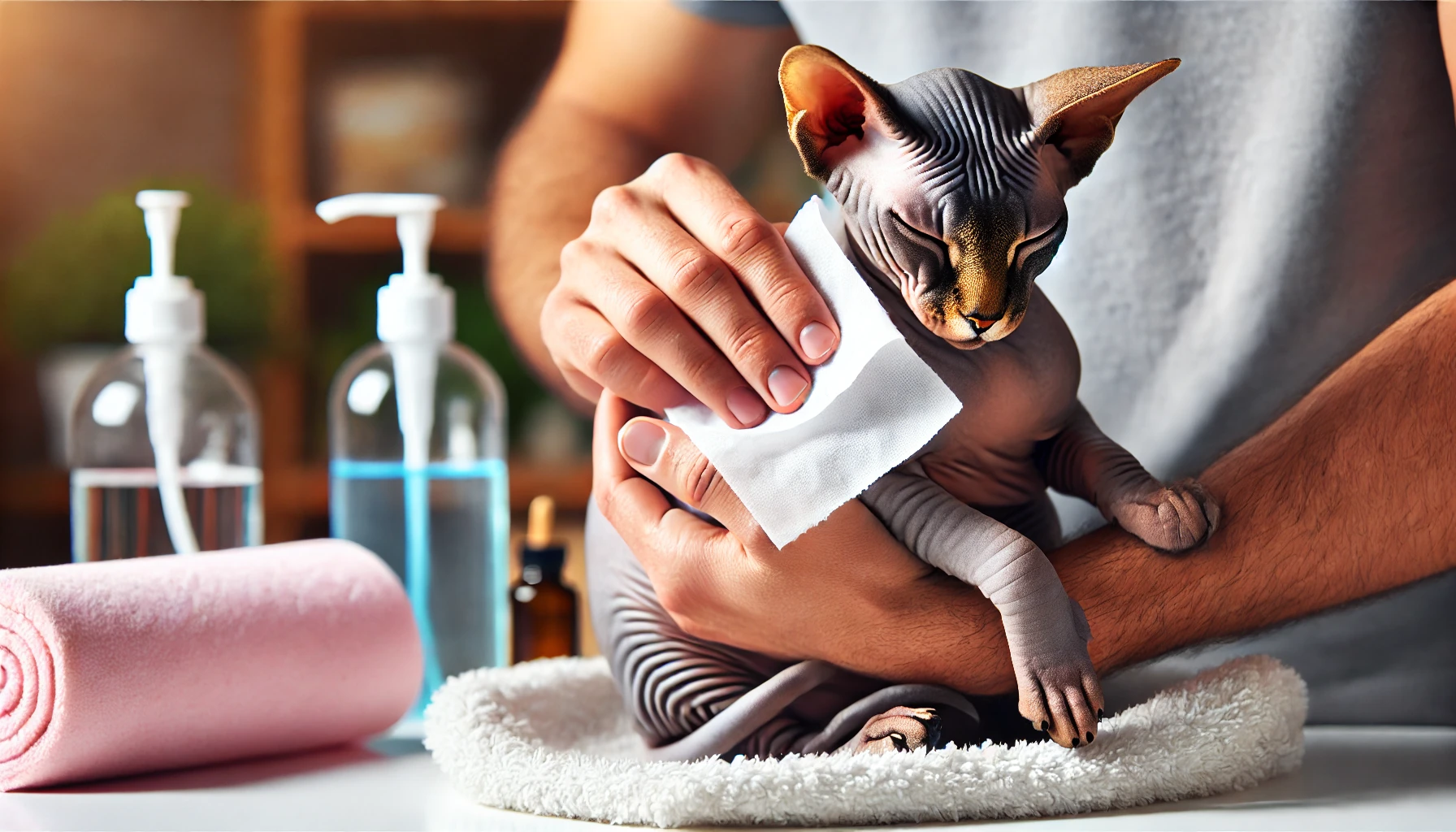
Managing and Preventing Dirt Buildup on Hairless Cat Skin
While regular baths are important for managing oil buildup, daily wiping can also help manage dirt between baths.
Gently wiping your cat’s skin with a damp, unscented baby wipe or a soft cloth can remove surface dirt and prevent oil from accumulating too quickly.
In addition, it’s essential to provide your hairless cat with a clean living environment.
Hairless cats are more exposed to environmental dust and dirt, so regular cleaning of their bedding and surroundings can reduce the amount of debris that settles on their skin.
- Daily Wiping: Use a damp cloth or unscented baby wipe to remove surface dirt between baths.
- Clean Environment: Regularly wash your cat’s bedding and keep their living area clean to minimize dirt accumulation.
- Regular Baths: Bathe your hairless cat weekly or bi-weekly, depending on how quickly oil and dirt build up.
Hairless cats produce more oil than furred cats, requiring more frequent cleaning to prevent oil buildup, dirt, and odor. Regularly wiping and bathing is essential to keeping their skin healthy.
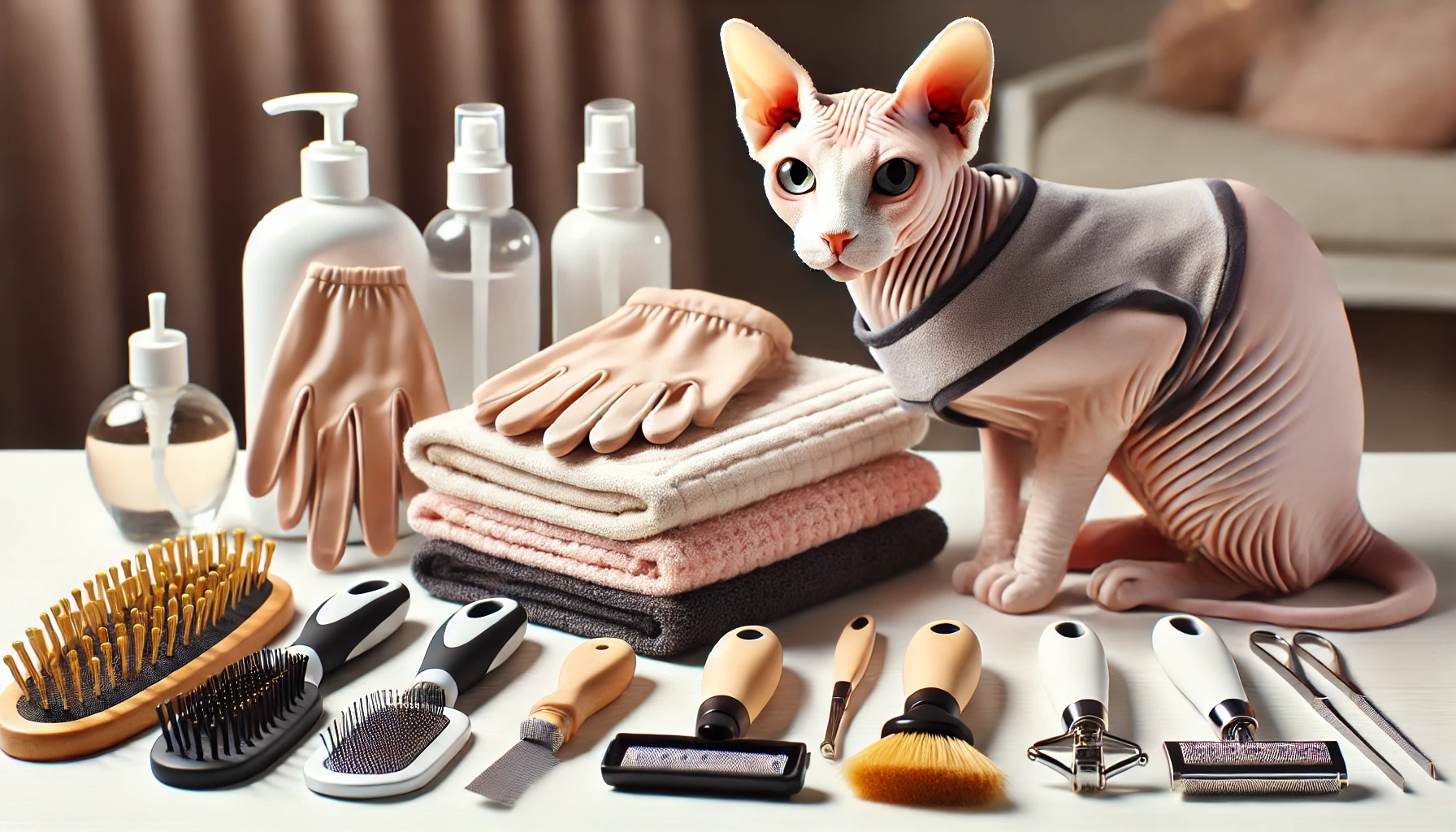
Grooming Tools and Techniques for Hairless Cats
Grooming hairless cats requires specialized tools and techniques to meet their unique needs.
Unlike furred cats, hairless cats need a delicate approach to avoid irritating their exposed skin.
You must be cautious when selecting the right tools and using the correct techniques to ensure your cat stays comfortable and doesn’t develop skin problems.
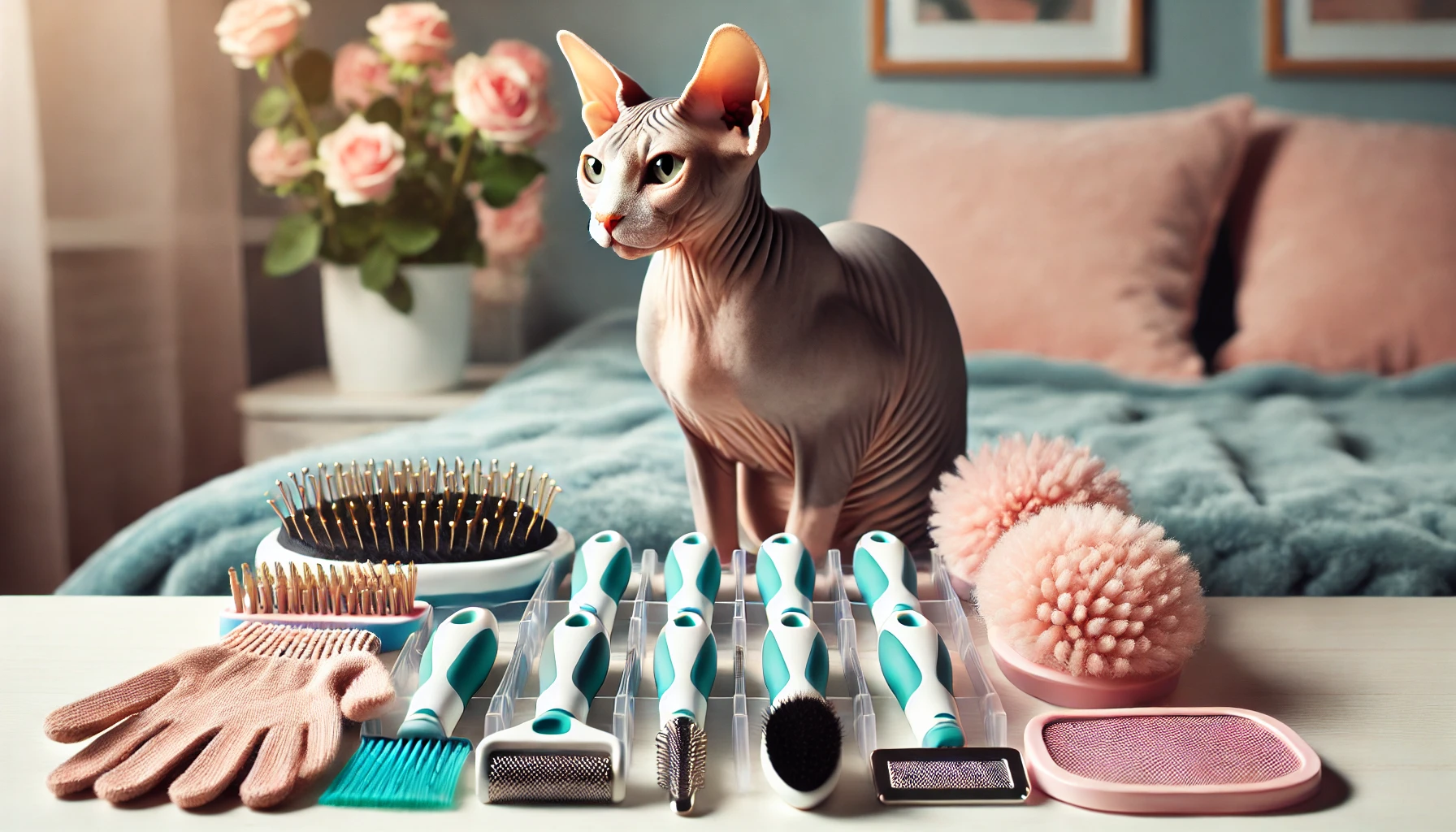
Choosing the Right Brushes and Grooming Tools
Although you might think hairless cats don’t need to be brushed due to their lack of fur, brushing is still a very useful grooming practice.
It helps remove dead skin cells and distribute natural oils across the skin, preventing oil from pooling in different areas.
Traditional cat brushes designed for furred breeds are often too harsh for hairless cats.
For hairless cats, soft grooming gloves or silicone brushes are ideal.
These tools exfoliate the skin and stimulate blood circulation while being gentle.
Avoid using metal or hard-bristled brushes, which can irritate or, at worst, cause microtears in the skin.
- Grooming Gloves: Soft grooming gloves allow you to gently remove dead skin cells and excess oils while bonding with your cat.
- Silicone Brushes: These brushes are soft on your cat’s skin and provide a relaxing massage.
- Microfiber Cloths: Use these to pat-dry your cat’s skin after a bath. They are absorbent and gentle, reducing the risk of irritation.
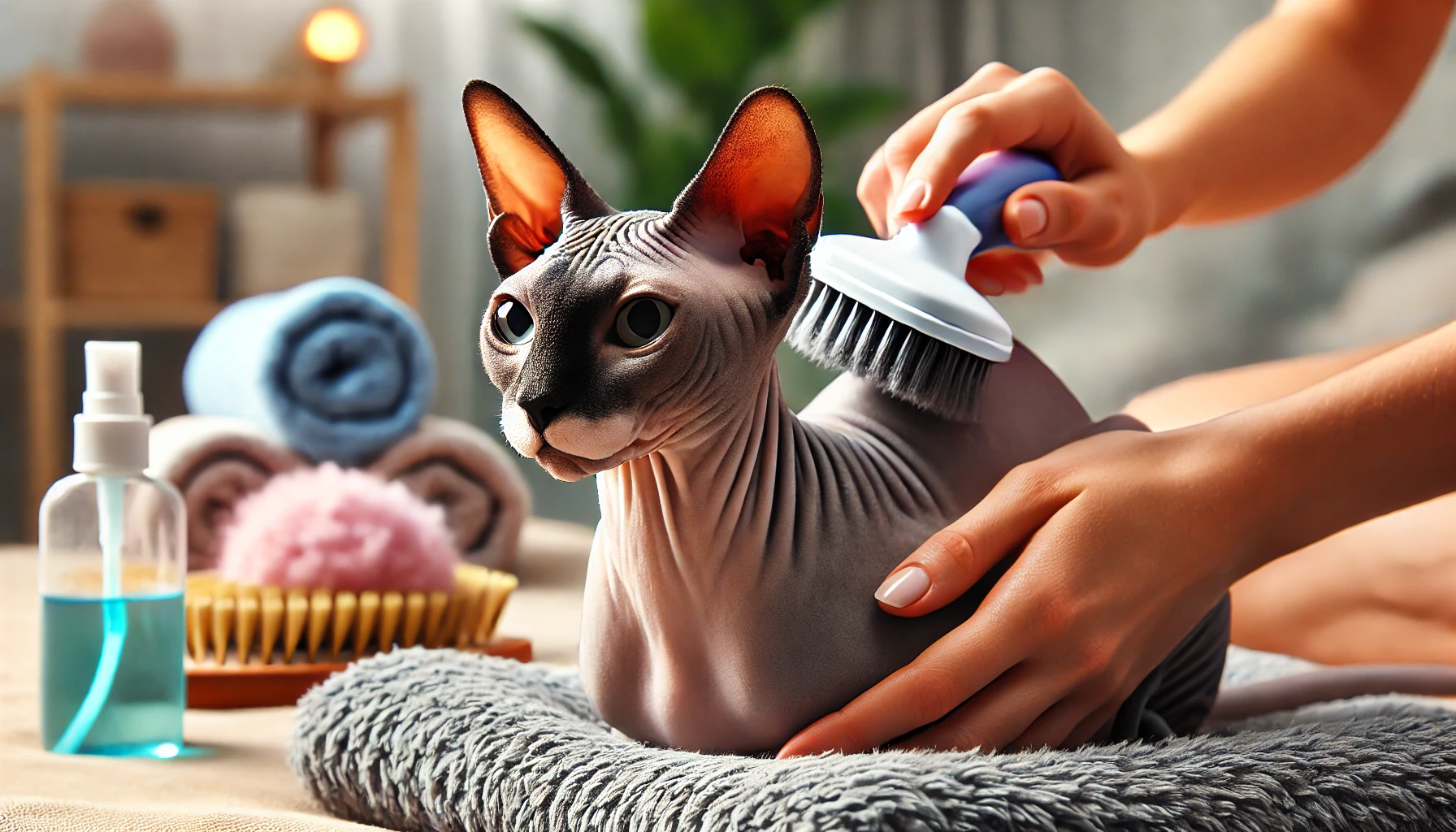
Proper Techniques for Safe Grooming
When grooming a hairless cat, always use gentle techniques to avoid irritation or discomfort.
Since their skin is more exposed, even minor abrasions can become problematic.
Use light, circular motions when brushing with soft-bristled brushes or grooming gloves to avoid pulling or stretching the skin.
Dry your cat’s skin by patting it with a soft towel or microfiber cloth.
Vigorous rubbing can cause irritation or dryness.
Make sure your cat’s skin is completely dry before applying any moisturizer, as damp skin can invite infections or fungal growth.
- Gentle Movements: Always use light, circular motions to avoid irritating the skin.
- Skin Drying: Pat—never rub—your cat’s skin after bathing to avoid irritation.
- Moisturizing: Once dry, apply a small amount of fragrance-free moisturizer to keep the skin hydrated.
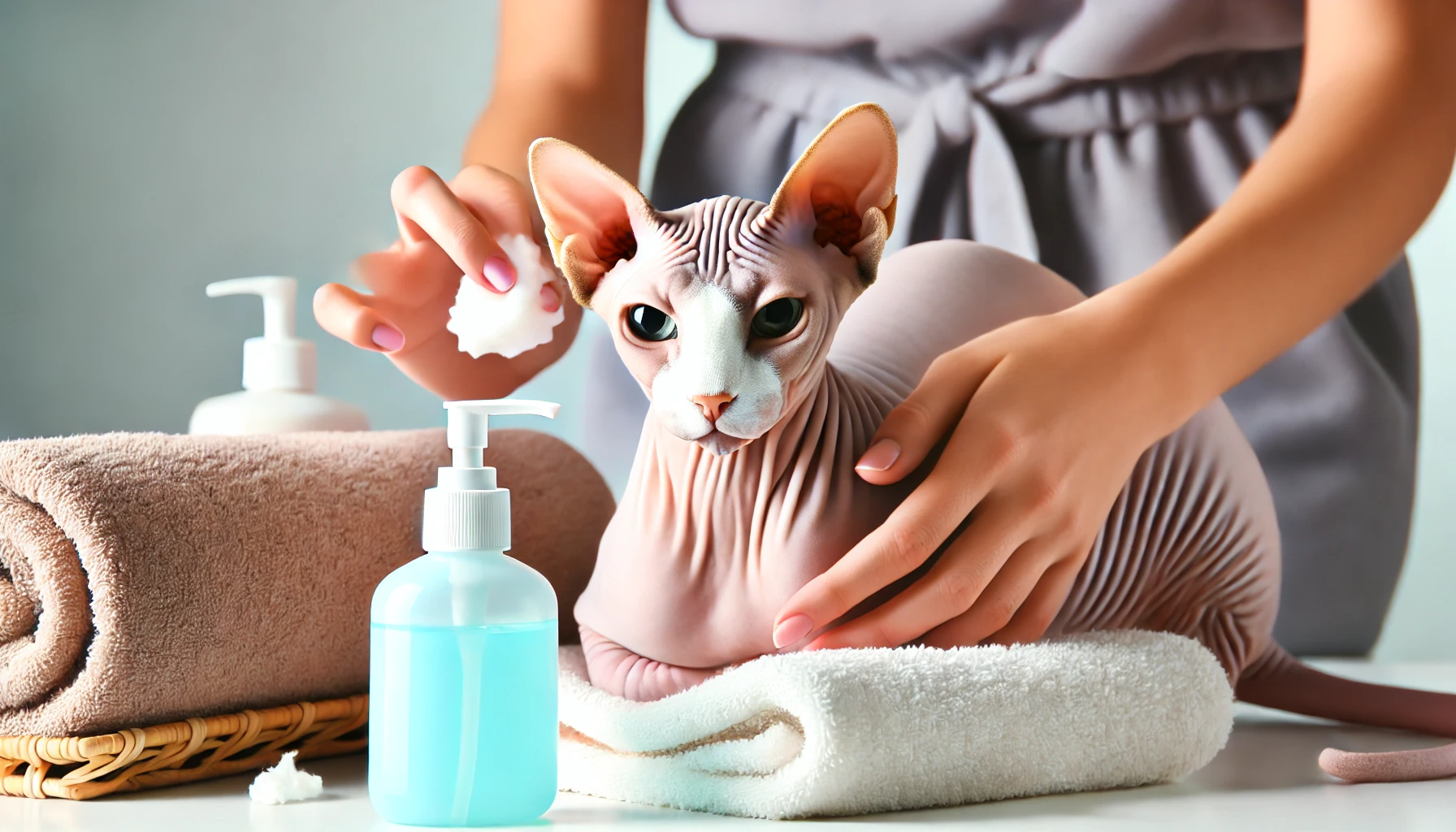
Tips for Grooming a Hairless Cat with Sensitive Skin
Hairless cats often have sensitive skin, so it’s important to use hypoallergenic products that are free from fragrances or harsh chemicals.
When selecting grooming products like shampoos and moisturizers, choose ones labeled for sensitive or hypoallergenic skin to prevent irritation and allergic reactions.
Additionally, keep grooming sessions short and comfortable for your cat.
If your cat seems stressed or uneasy, consider breaking the grooming process into shorter sessions.
This can make grooming less stressful and help your cat associate it with positive experiences.
- Hypoallergenic Products: Use only grooming products designed for sensitive skin to avoid irritation.
- Short Sessions: Keep grooming sessions brief to reduce stress for your cat.
- Observe for Irritation: Regularly check your cat’s skin for signs of irritation or dryness and adjust your grooming routine as needed.
Use soft grooming gloves or silicone brushes to gently exfoliate and clean the skin of hairless cats. Avoid hard bristles that can irritate their sensitive skin.
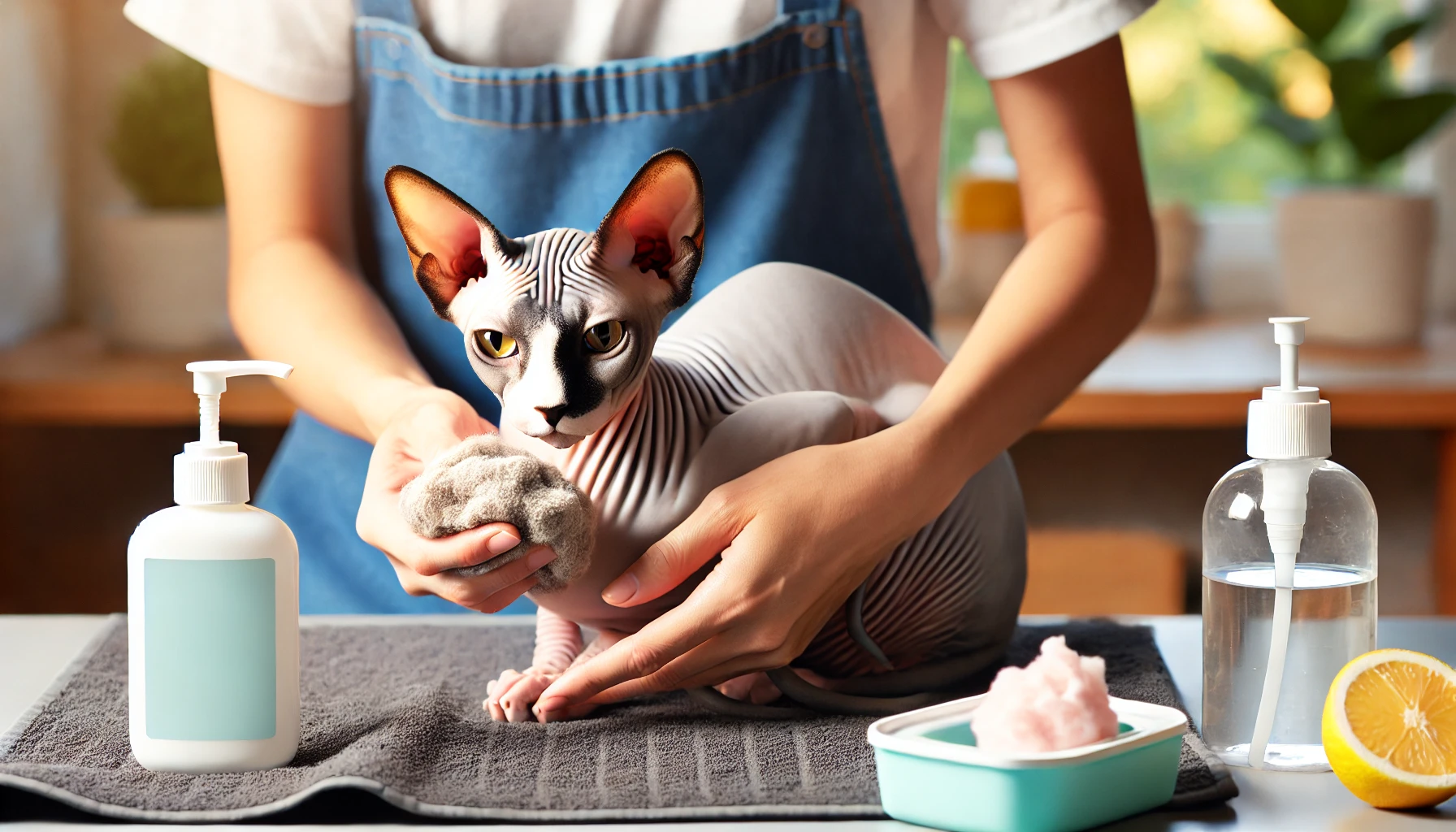
Addressing Common Grooming Challenges for Hairless Cats
Hairless cats face several unique grooming challenges due to their lack of fur.
While the grooming needs of hairless cats differ from those of furred cats, they are no less demanding.
The following will discuss how to address some of the common grooming challenges to keep your hairless cat healthy and comfortable.
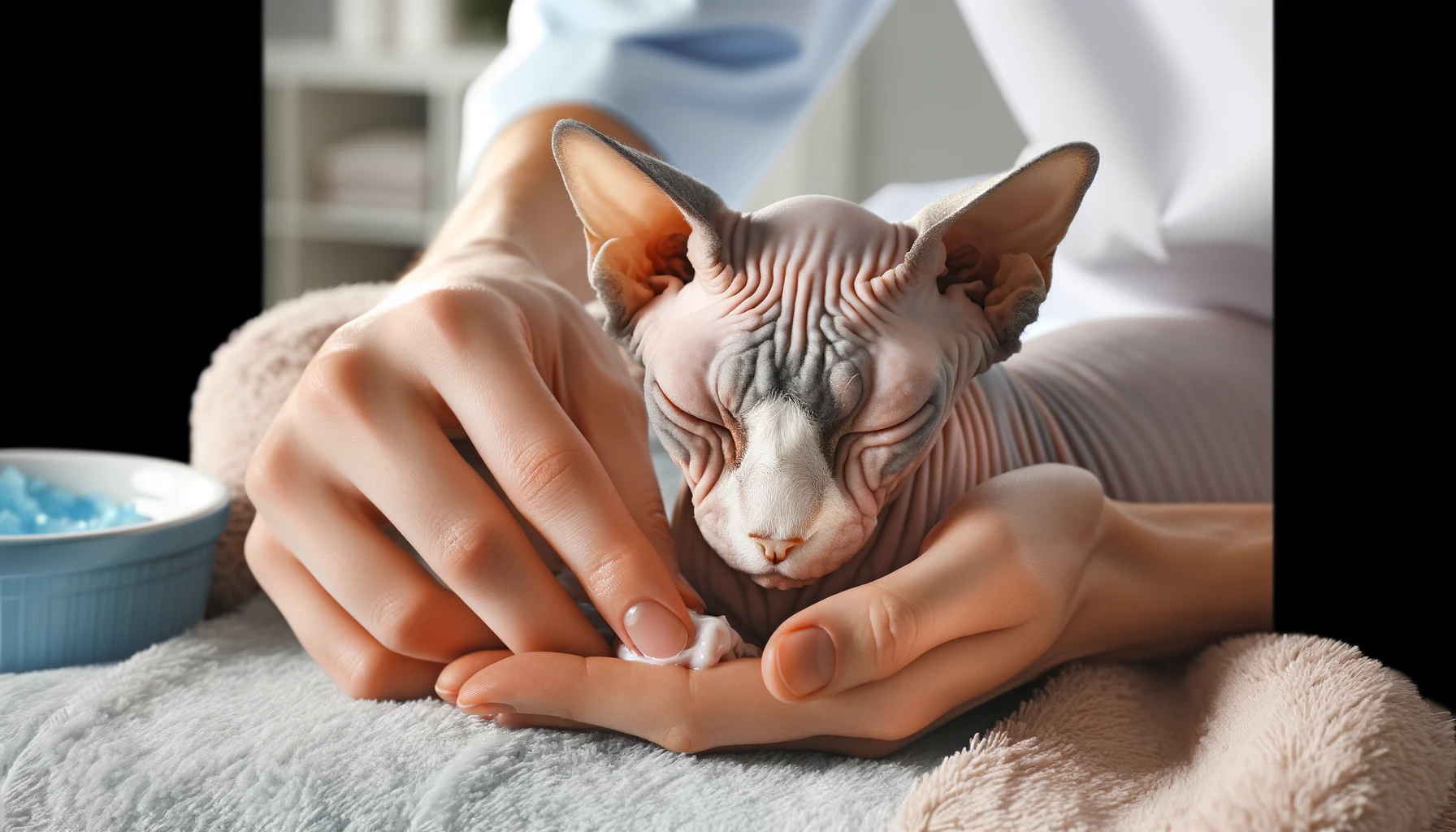
Dry Skin and Flakiness
Complaints about dry skin and flakiness are common in hairless cats.
Because they lack fur, their skin is directly exposed to environmental elements and can quickly lose moisture, leading to dryness and irritation.
To prevent this, it’s important to moisturize your hairless cat’s skin regularly.
Use a fragrance-free, hypoallergenic cream or lotion made specifically for pets.
Avoid products containing artificial fragrances or harsh chemicals, as they can further dry out the skin and potentially inflame sensitive areas.
Additionally, ensure that your home isn’t too dry.
A humidifier can help maintain a comfortable level of humidity, keeping your cat’s skin hydrated.
Bathing them regularly using a moisturizing cat shampoo can help prevent flakiness, as long as you ensure their skin is thoroughly dried after bathing to avoid further irritation.
- Moisturizing: Apply a fragrance-free, non-irritating moisturizer regularly to prevent dryness.
- Humidifier: Using a humidifier can help maintain moisture in the air, preventing dry skin.
- Regular Baths: Bathe your hairless cat with a moisturizing shampoo and ensure they are properly dried afterward.
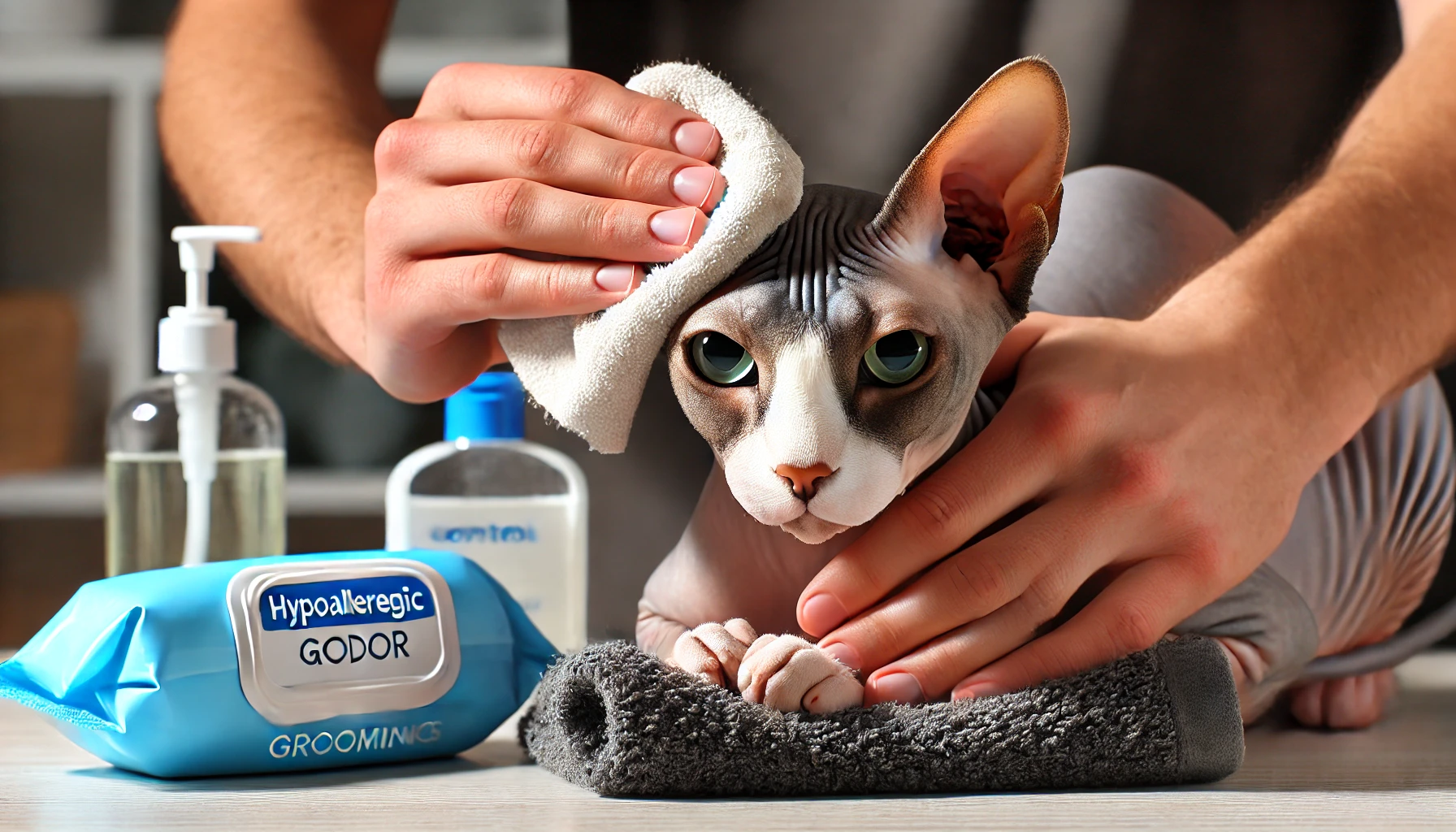
How to Control Odor in Hairless Cats
Hairless cats can have a stronger body odor due to oil buildup on their skin, which isn’t absorbed into fur.
This becomes more noticeable if regular grooming is neglected.
To manage odor, it’s essential to stick to a consistent bathing routine, thoroughly cleaning your cat’s skin to remove excess oils and dirt.
Use an unscented shampoo to avoid irritating their sensitive skin.
It’s also important to clean areas prone to oil buildup, such as the ears and skin folds.
Wiping these areas regularly between baths with a damp cloth or unscented baby wipe will help control odor.
- Regular Baths: Bathe your hairless cat regularly to prevent oil buildup, which causes odor.
- Skin Fold Cleaning: Wipe down areas prone to oil buildup, like the ears and skin folds, between baths.
- Unscented Products: Use unscented grooming products to avoid irritation while keeping your cat clean.
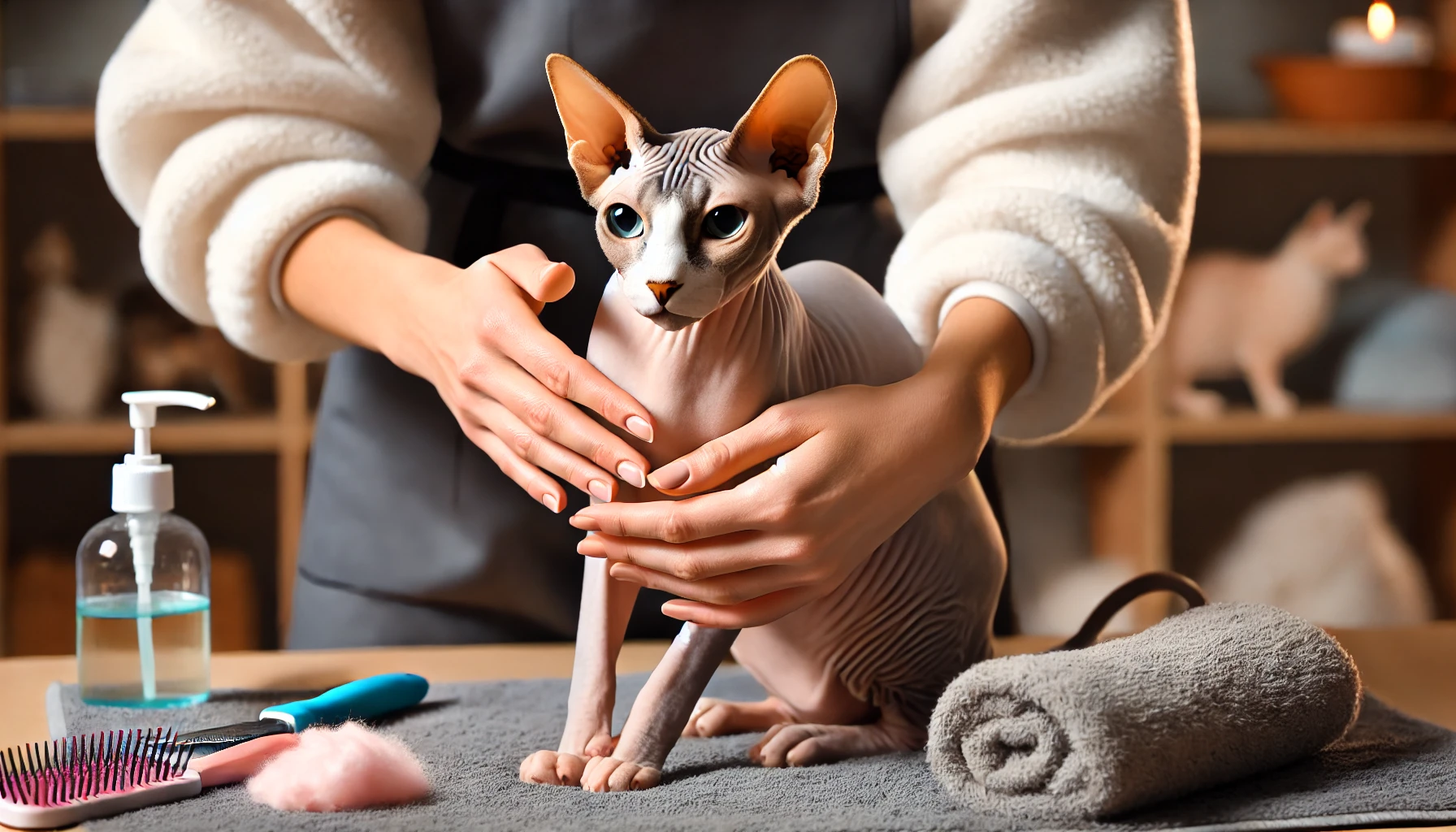
Tips for Grooming Reluctant or Anxious Cats
Some hairless cats find grooming stressful, especially if the process is new to them.
If your cat becomes anxious or fidgety during grooming, try to make the experience as positive as possible.
Start by introducing them to the grooming tools and processes gradually, rewarding them with treats or praise during the session.
Keeping grooming sessions short and calm can help reduce stress.
Sometimes, it may be helpful to break the grooming process into smaller steps.
For example, you could clean your cat’s ears and paws one day and bathe them the next.
This approach can make grooming less stressful for both you and your cat.
- Positive Reinforcement: Reward your cat with treats and praise to make grooming a positive experience.
- Short Sessions: Keep grooming sessions as short as possible to reduce stress.
- Break It Down: If your cat is anxious, break the grooming routine into smaller, manageable steps.
Hairless cats are prone to dry skin and flakiness. Regular moisturizing and a humid environment can prevent skin issues while regular baths help control odor and oil buildup.
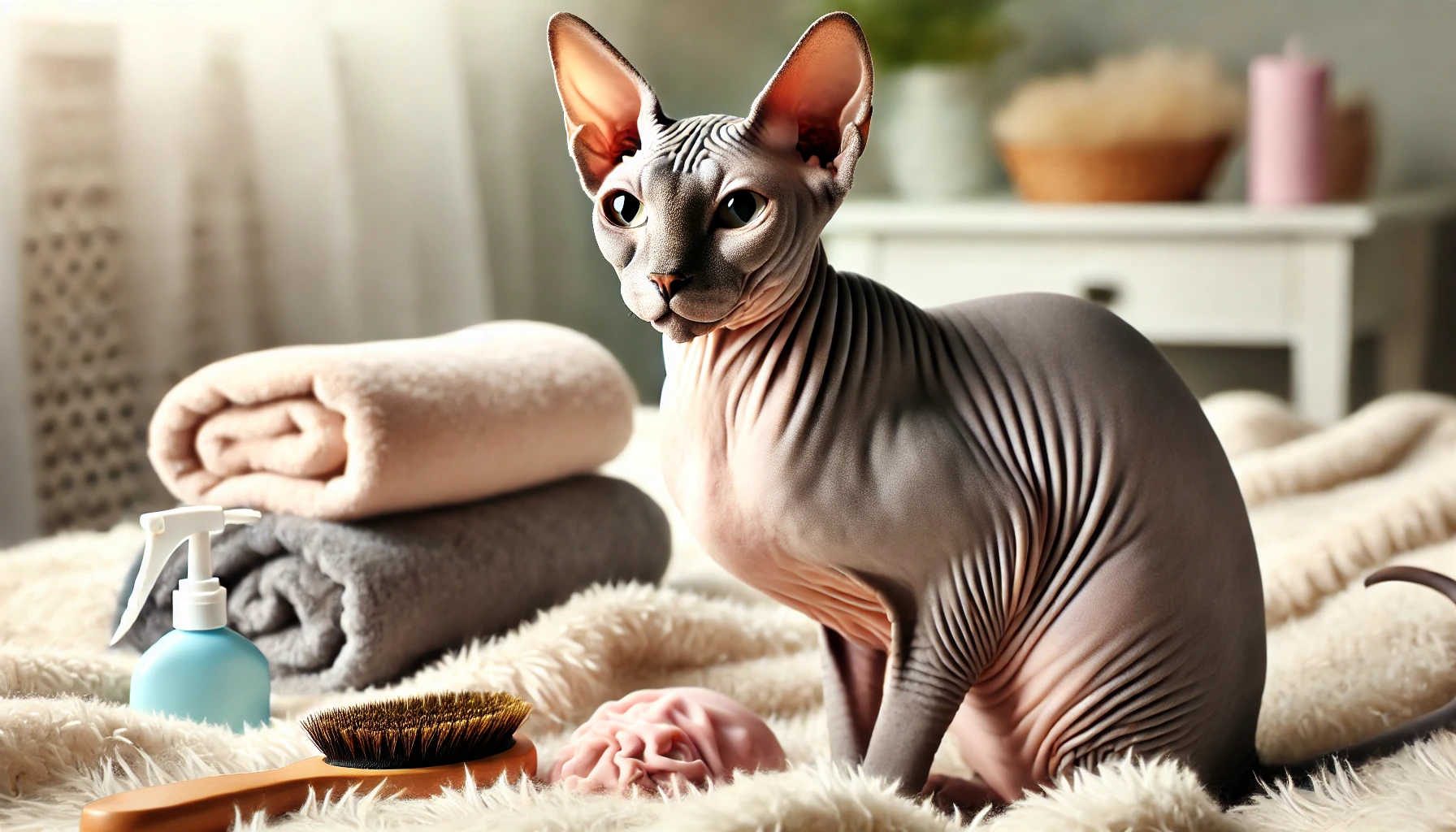
Final Thoughts on Addressing Grooming Challenges with Hairless Cats
Grooming a hairless cat comes with unique challenges.
Cleaning dirt and oil buildup and keeping the skin moisturized requires a thoughtful and consistent grooming process.
While the lack of fur might suggest less maintenance, hairless cats need just as much, if not more, attention to keep their skin clean and free of irritation.
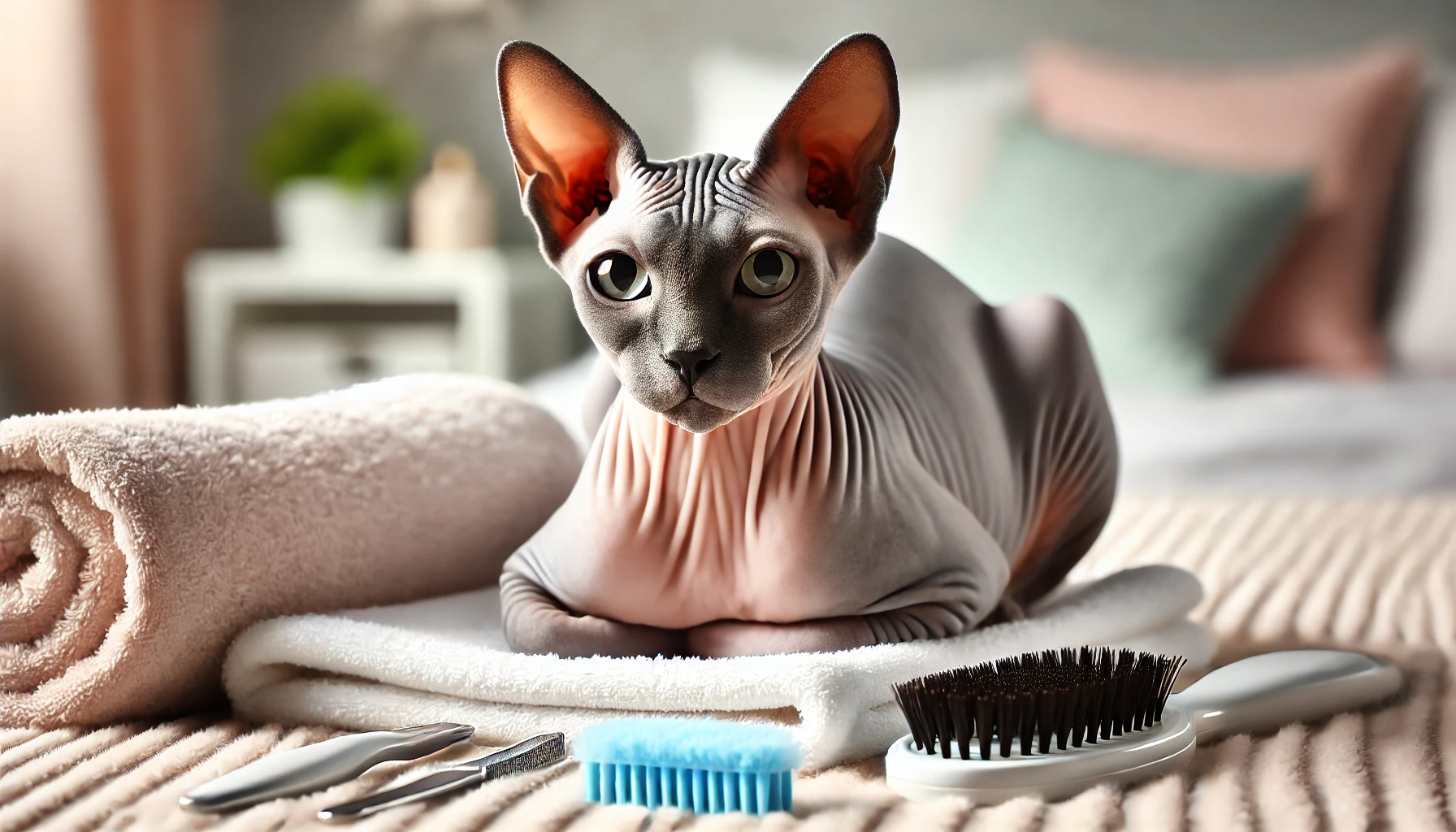
Points to Remember
When caring for your hairless cat, it’s essential to focus on specific elements to ensure they remain healthy.
Below are key points that address the grooming challenges and solutions discussed throughout the article.
- Skin Moisturization: Regular application of a fragrance-free, hypoallergenic moisturizer is crucial to prevent dry skin and flakiness.
- Bathing Routine: A weekly or bi-weekly bath with a moisturizing, unscented shampoo will help manage oil buildup and prevent skin issues such as acne or rashes.
- Odor Control: Cleaning areas prone to oil buildup, like ears and skin folds, between regular baths will help minimize body odor.
- Gentle Grooming Tools: Using soft grooming gloves or silicone brushes ensures a non-invasive approach that won’t irritate exposed skin.
- Managing Stress During Grooming: Short grooming sessions, positive reinforcement, and breaking the routine into smaller steps will reduce your cat’s anxiety.
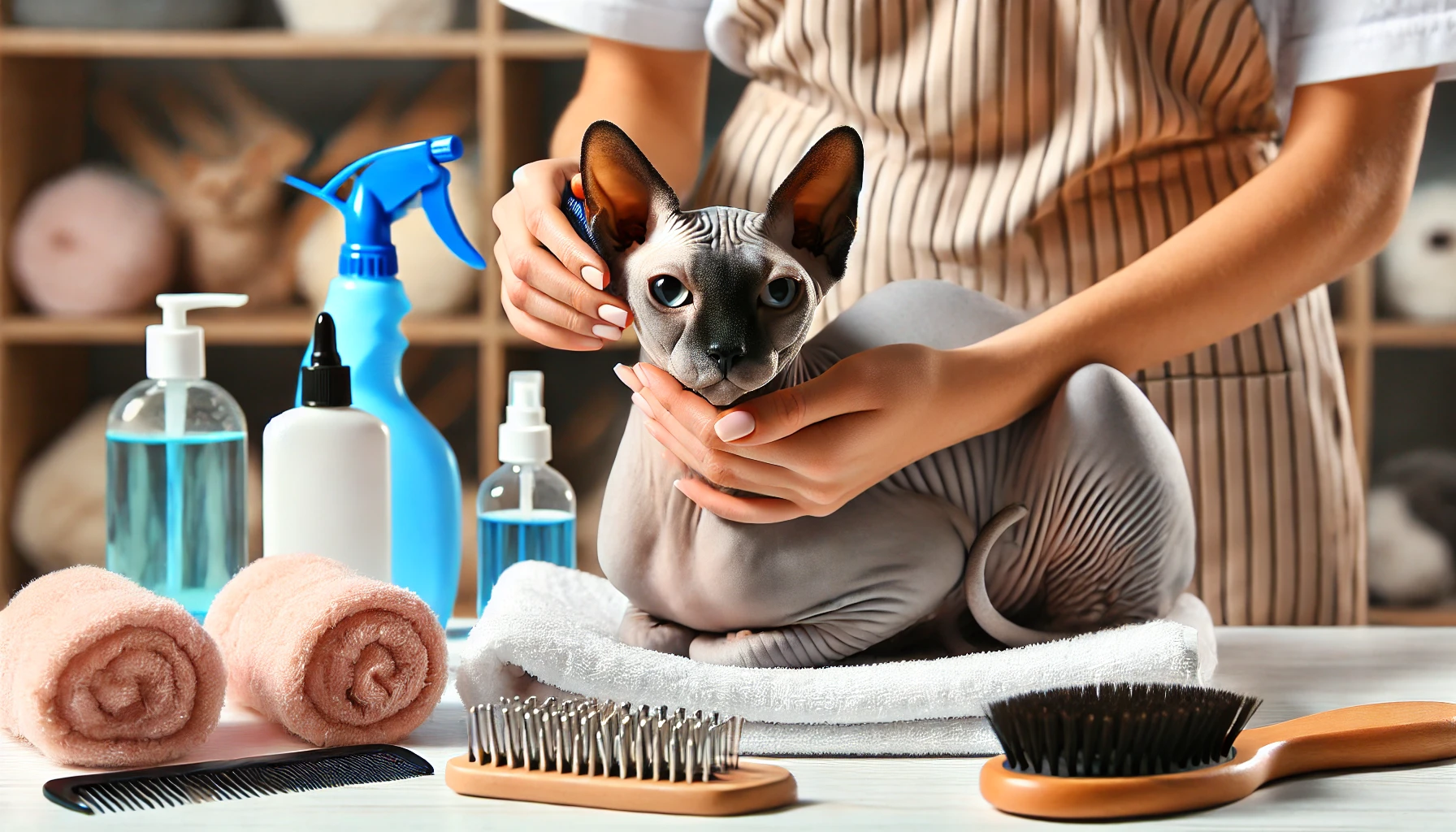
Building a Consistent Routine
The key to addressing grooming challenges with hairless cats is establishing a consistent routine.
Regular bathing, moisturizing, and cleaning specific areas are essential for maintaining your cat’s overall health and comfort.
A consistent grooming routine will help prevent common issues such as dry skin, flakiness, odor, and skin irritations that are often seen in hairless breeds.
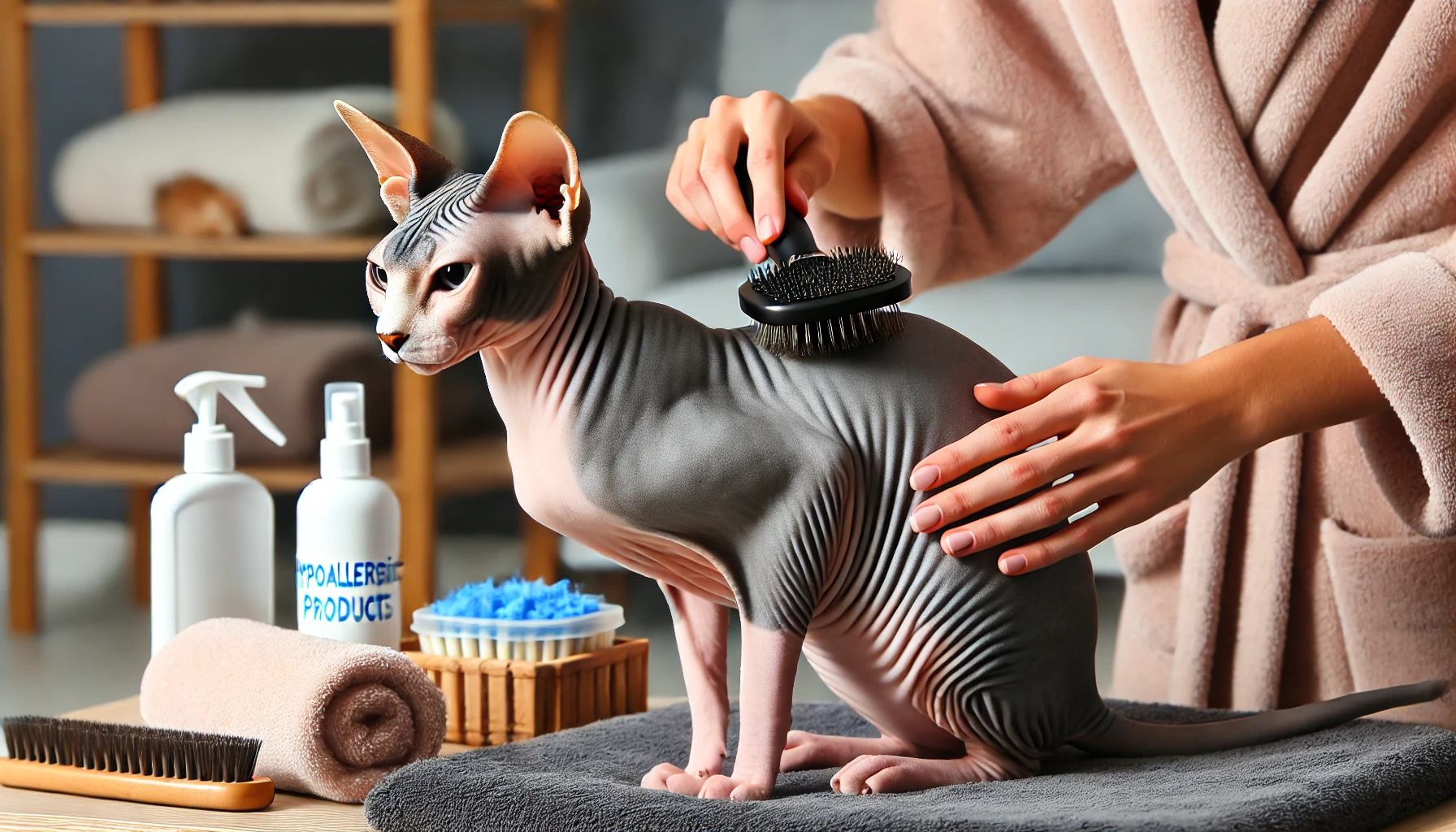
Personalizing the Grooming Experience
Every hairless cat is unique, and their grooming routine may need to be tailored to their individual needs based on factors like skin sensitivity, activity level, and personal preferences.
By carefully observing your cat and adjusting their grooming regimen accordingly, you can ensure their comfort.
Whether it’s choosing the right grooming tools or timing their baths, personalizing the grooming experience can go a long way in keeping your hairless cat happy and healthy.
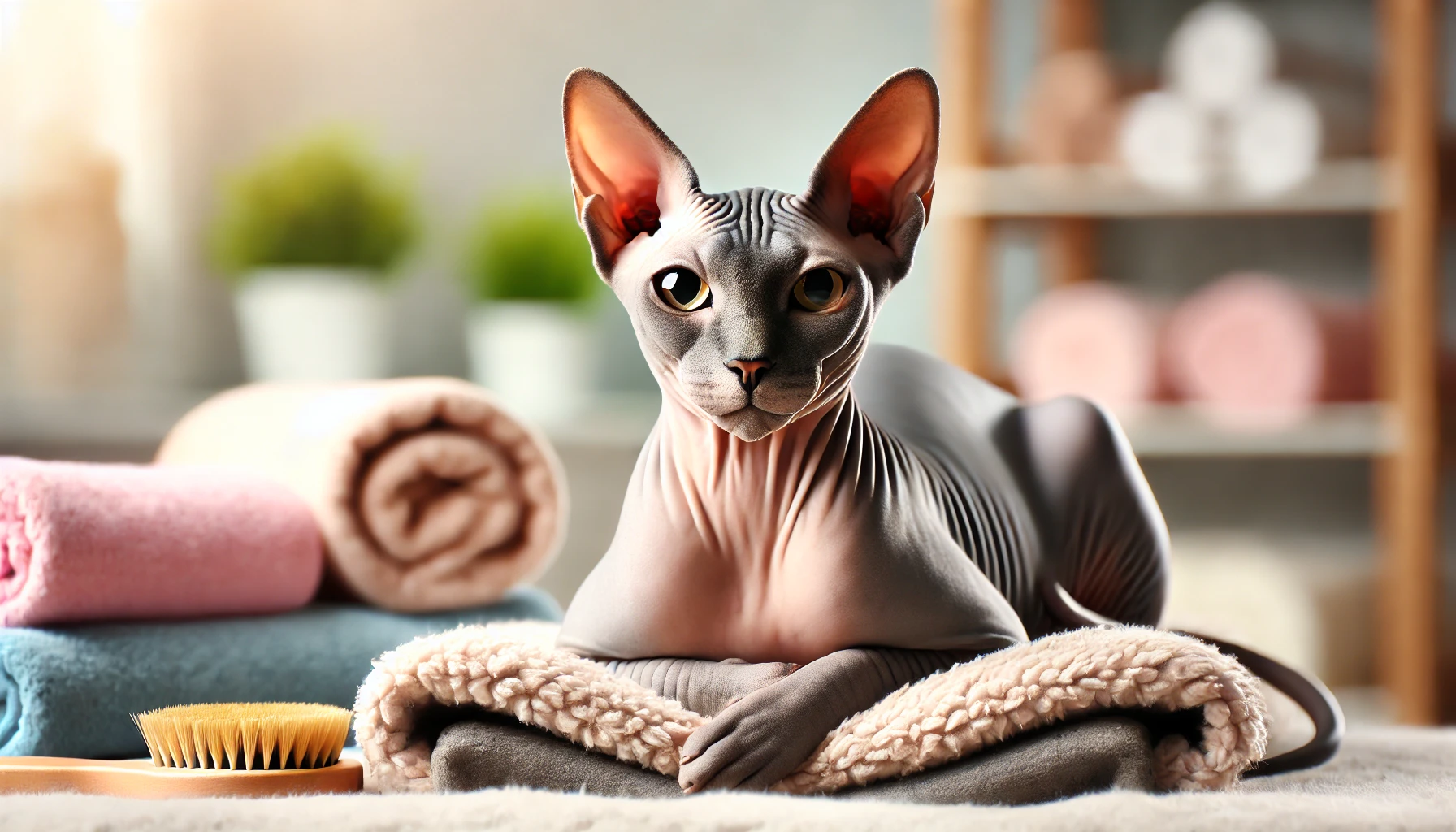
The Reward for Careful Grooming
While grooming hairless cats requires extra care and effort, the rewards are worth it.
A well-groomed cat not only looks better but feels better too.
By addressing the grooming challenges of your hairless cat with care and consistency, you’ll help ensure their health, comfort, and confidence in their environment.
Understanding the grooming challenges that hairless cats face and implementing the right solutions will keep your feline companion’s skin healthy and their grooming experience less stressful.
Embrace the process, and you’ll build a strong bond with your cat through regular grooming.
Grooming a hairless cat can be challenging, but with the right tools, products, and routines, you can ensure your feline remains healthy, happy, and comfortable.
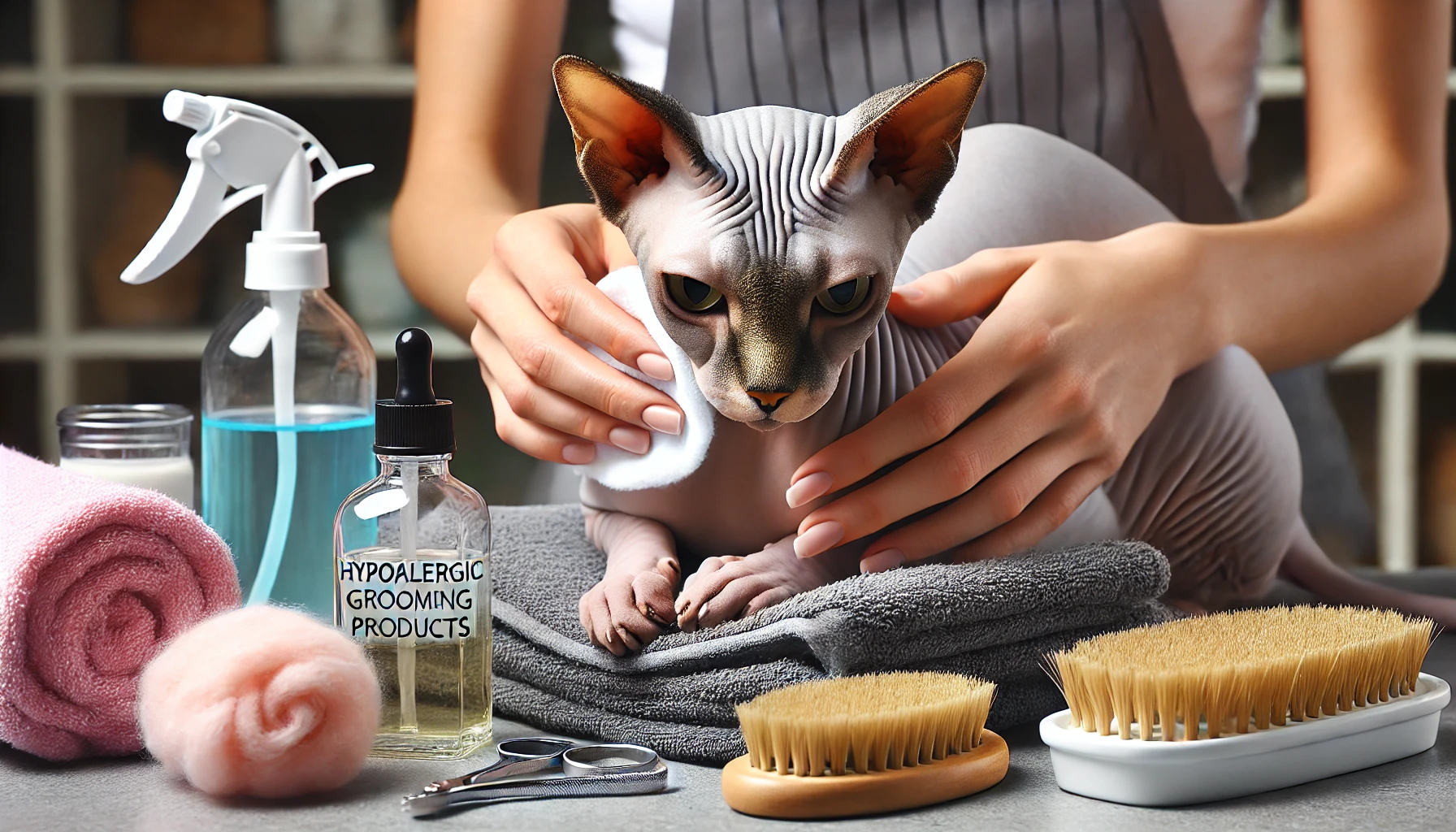
Frequently Asked Questions about Grooming Challenges of Hairless Cats
Grooming hairless cats can be a bit of a challenge in many areas.
Here are some of the most frequently asked questions along with their answers to help you take better care of your hairless feline companion.
How often should I bathe my hairless cat?
It is best to bathe a hairless cat once or twice per week to remove oils and dirt that build up on the skin.
This may vary depending on your cat’s oil production and activity level.
What type of moisturizer is safe for hairless cats?
Use an unscented, hypoallergenic moisturizer designed for pets.
Skin care products for humans should not be used on hairless cats as they contain chemicals that can irritate or burn their sensitive skin.
Why does my hairless cat smell worse?
Hairless cats may develop a stronger odor because the oil on their skin is not absorbed into fur.
Regular bathing and cleaning areas like ears and skin folds can help manage this odor.
Can I bathe my hairless cat with human shampoo?
No, human shampoos are not recommended for hairless cats.
Use a moisturizing, unscented cat shampoo to avoid irritating their skin and to maintain proper skin care.
How do I keep my hairless cat’s skin from getting dry?
Regular moisturization with a cat-safe, hypoallergenic product, the use of a humidifier in dry environments, and maintaining a consistent grooming routine will help prevent dry skin and flakiness in your hairless cat.
How can I reduce grooming-related stress for my hairless cat?
Keep grooming sessions short.
Use positive reinforcement, such as treats or praise.
If your cat is very anxious, break the grooming routine into smaller steps to make the experience less stressful.
What kinds of grooming tools should I use on my hairless cat?
For hairless cats, soft grooming gloves or silicone brushes are ideal.
These tools gently exfoliate the skin, removing oils and providing a gentle massage without causing irritation or discomfort.
Are hairless cats more prone to skin infections?
Yes, hairless cats are more prone to skin infections due to oil accumulation on the skin and the absence of fur.
Regular cleaning, proper moisturizing, and careful attention to skin health will help prevent infections.
Do hairless cats require regular cleaning of the ears?
Yes, hairless cats are prone to wax buildup in their ears.
Clean their ears with a damp cloth or cotton ball using a non-irritating cat ear cleaner to avoid infections and odor.

